Get the Most out of Your Tea with Chinese Teaware
At Hey China we know the perfect cup of tea isn’t just about the leaves; it’s also about the teaware you use to make and drink it. We have a beautiful range of authentic Chinese teaware to elevate your tea experience and bring a bit of elegance to your tea time. Whether you’re a tea aficionado or just starting out on your Chinese tea journey, we have everything you need to brew and enjoy tea the traditional Chinese way.
Our Chinese Tea Sets
Our Chinese teaware includes everything you need to set up your perfect tea at home. Each piece is made with love and care, reflecting the rich history of Chinese tea.
- Tea Cups: Our Chinese tea cups are designed to match the flavour of your favourite teas. From simple to intricate designs, our tea cups are for any tea occasion.
- Tea Pots: The tea pot is the heart of any tea ceremony. Our Chinese tea pots are made from high quality materials like Yixing clay and porcelain so every brew is infused with the full flavour of the tea leaves.
- Cast Iron: Our cast iron teapots retain heat and preserve the flavor of tea, available in various designs and colors, making them exquisite serving options for multiple servings.
- Tea Trays: A tea tray is essential for serving tea, catching spills and displaying your teaware beautifully. Our Chinese tea trays include traditional wooden trays and modern designs, all to enhance your tea time.
- Tea Tools: For the true tea lover, our Chinese tea tools include tea accessories like scoops, spoons, whisks, strainers, and infusers. These tools are functional and add authenticity to your tea ritual.
- Matcha Bowl: An essential item for creating an authentic and enjoyable matcha experience.
- Matcha Whisk: A quality bamboo chasen is crucial for achieving the right froth and flavor in your matcha tea.
- Tea Sets: Our Chinese tea sets make a great gift or addition to your own collection. Complete with matching tea cups, tea pots and accessories, our tea sets are available in many styles to suit everyone.
- Tea Storage: Proper storage is key to keeping your tea fresh. Our Chinese tea storage solutions include beautifully crafted containers that protect your tea from light, air and moisture and add a decorative touch to your kitchen or tea room.
Why Chinese Teaware from Hey China?
Authenticity
All our Chinese teaware is made the traditional way so each piece is not only beautiful but also true to the history and culture of Chinese tea. Whether you’re choosing a simple tea cup or a full tea set, you can be sure you’re getting an authentic product made by skilled craftsmen.
Elevate Your Tea Drinking Experience
The right teaware can make all the difference to your tea drinking experience. Our Chinese tea pots, cups and accessories are designed to bring out the best in your tea so you can fully appreciate the flavour and aroma. Whether you’re having a cup on your own or with friends, our teaware makes every tea time special.
Variety of Premium Loose Leaf Teas
Hey China has a wide range of Chinese teaware to suit everyone. Whether you’re looking for a traditional tea pot or a modern tea tray, we have something for you. Browse our range and find your perfect teaware to match your tea collection.
Gift Giving
Our Chinese teaware also makes a great gift for any tea enthusiast. Whether it’s a special occasion or just to share the love of tea, our beautifully crafted tea sets and accessories will impress.
- 92 Tea Cups
- 26 Tea Pots
- 19 Tea Trays
- 7 Tea Tools
- 19 Tea Sets
- 1 Tea Storage
Product Filters
Filter by Category
Filter by Pu-erh Type
Filter by Type
Filter by Taste
Filter by Origin
Filter by Caffeine Level
Filter by Leaf Form
Filter by Brand
Filter by Colour
Filter by Material
Filter by Number of Pieces
Filter by Colour
Filter by Material
Filter by Size
Filter by Colour
Filter by Material
Filter by Size
Filter by Colour
Filter by Material
Filter by Size
163 Products
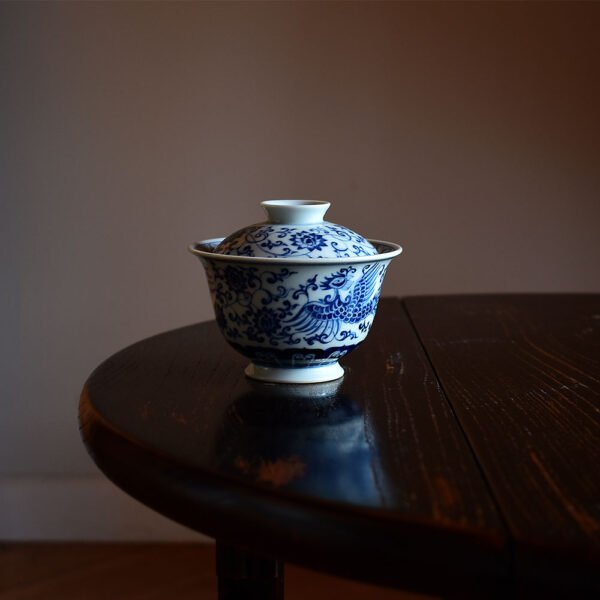
 $520.99
$520.99This charming Gaiwan is using blue and white porcelain craftsmanship, made entirely by hand.
One of the patterns depicts a pair of phoenixes. The phoenix, known as the “Fenghuang” in Chinese, is a mythical bird considered to be the king of all birds and a symbol of auspiciousness, beauty, and grace. It represents virtue, harmony, and the union of yin and yang. When depicted as a pair, the double phoenix symbolizes the ideal relationship between a male and a female. It represents the union of two exceptional individuals or the coming together of two extraordinary things. It signifies a harmonious and balanced partnership, whether in love, marriage, or any collaborative endeavour. The double phoenix is often associated with blessings, prosperity, and good fortune. It is believed to bring luck, happiness, and success, as well as symbolize marital bliss, loyalty, and everlasting love.
Another pattern used on this Gaiwan is Chanzhi Lian. Chanzhi Lian, also known as “Interlock Branch Lotus,” is a Chinese decorative motif with the symbolism of “flowers within flowers, blossoms within leaves.” It is also referred to as the “Wanshou Teng,” representing auspiciousness and longevity due to its continuous and interconnected structure, symbolizing the concept of “endless vitality.” In addition, in traditional Chinese Confucian culture, the lotus is seen as the embodiment of truth, goodness, and beauty, as well as a symbol of Buddhism. The pronunciation of “Lian” is similar to the word “continuous” in Chinese, further expressing the idea of continuous growth and conveying positive wishes and emotions.
As part of Chinese traditional ornamentation, Chanzhi Lian has been passed down through generations, reflecting its own beauty and cultural significance with a unique artistic charm. The lotus possesses a sacred and pure temperament, being beautiful without being ostentatious and magnificent without being vulgar. It is precisely because of this aesthetic appeal that Chanzhi Lian has become a decorative pattern applied to various aspects of life.
The texture of this Gaiwan is delicate and smooth, and the painting is lively and lifelike. The entire production process is completed by hand, with every detail carefully designed and polished, giving this Gaiwan a unique artistic charm. This tea ware by imitating the shape and style of traditional Chinese tea ware, allowing people to appreciate the charm of traditional art and experience the flavour of history. The elegant lines, smooth curves, and delicate decorations present a sense of refined and harmonious beauty, allowing people to experience pleasure and artistic enjoyment while tasting tea.
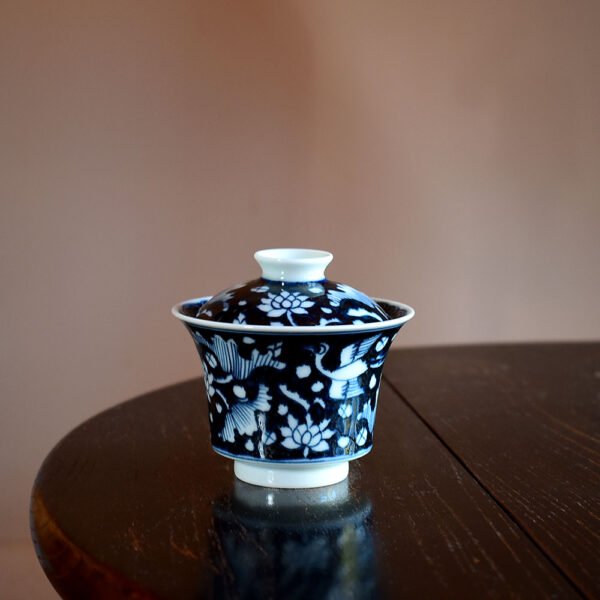
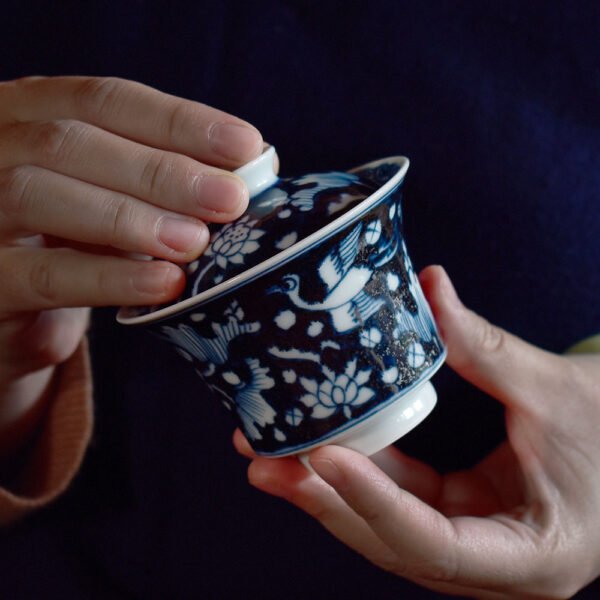 $279.99
$279.99This Gaiwan is made in the style of the Yuan dynasty blue and white porcelain, completely handmade and hand-painted. The pattern of “一鹭莲科” or “一路连科” in Chinese culture is derived from the beautiful combination of the heron and lotus leaves. As “鹭” (heron) and “路” (path/road) have the same pronunciation, and “莲” (lotus) sounds like “连” (successive/continuous), the name “一路连科” is a play on words that conveys the beautiful meaning of the pattern. In ancient times, successive successful candidates in the imperial examinations were called “连科,” and “一路连科” is a good wish for students to have a smooth career path and achieve success step by step.
For Yuan blue and white porcelain refers to the blue and white porcelain produced during the Yuan dynasty (1271-1368) in China. The Yuan dynasty was an important period in the history of Chinese porcelain and one of the peaks of Chinese porcelain art. As one of the representatives of that era, Yuan blue and white porcelain exhibited unique artistic styles and technical levels. The characteristic of Yuan blue and white is the use of cobalt blue pigment for painting, which is made of cobalt oxide. After firing, the colour is bright and rich, with an extremely high decorative effect. Yuan blue and white porcelain has various shapes, thick and heavy, concise, and fluent lines, and stable and solemn shapes, all made exquisitely.
The evolution of Yuan blue and white is based on the foundation of the Tang and Song celadon. Firstly, the glaze colour was improved and innovated. Unique white glaze, eggshell glaze and blue-white glaze were invented to make the glaze crystal clear. Cobalt pigment was imported for glaze colouring. Or using pigment made from domestic materials.
The formation of tin spots on Yuan blue and white is due to the high content of iron elements in local parts of the blue pigment. After reaching saturation in the high-temperature glaze solution and cooling down, the iron elements in the supersaturated part start to precipitate. If the iron content of the blue pigment is higher and the cooling rate is appropriate, tin spots are more likely to appear on the surface of the ware.
In addition to firing and materials, the formation of tin spots also involves the factor of glaze material. During the painting process, tin spots can also be formed due to the accumulation of blue pigment. Tin spots are more likely to appear on the surface of the ware at the intersections and the starting and ending points of brushstrokes. The formation of tin spots can be said to be a natural creation or an artificial decoration.
This Gaiwan has a thick body and uses the Su Ma Li Qing glaze material (a kind of blue pigment), with a heavy sense of tin spots, revealing a unique charm of the past era. The entire production process is completed by hand, and every detail has been carefully designed and polished, giving this Gaiwan a unique artistic charm.
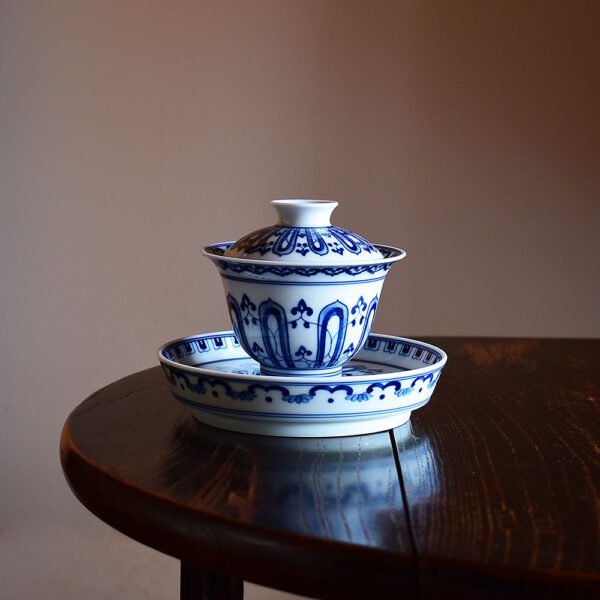
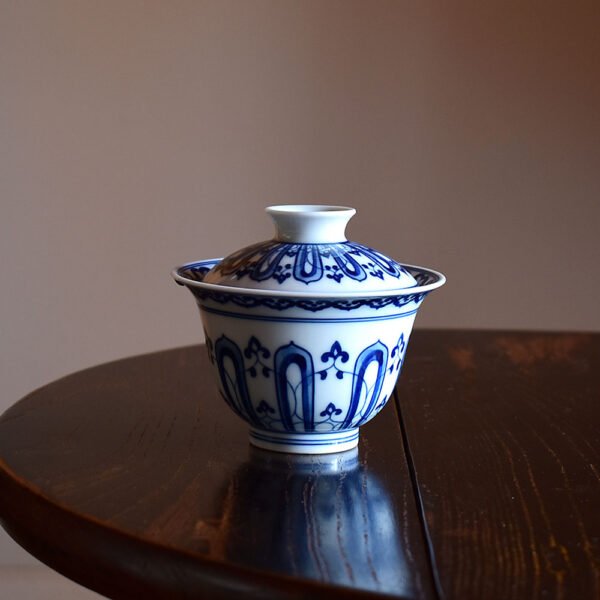 From: $389.98
From: $389.98This tea set is completely handmade and hand-painted. The pattern featured is called “Bao Xiang” in Chinese, which is a traditional decorative motif representing one of the auspicious three treasures (Bao Xiang flower, Money tree, and Treasure basin), prevalent during the Sui and Tang dynasties in China. Bao Xiang pattern is also known as ‘Bao Xian Hua’ or ‘Bao Lian Hua’. Its lines are clear, and the colour is serene and antique. The Bao Xiang pattern design of this teaware is neat, and complex but not messy, and the whole picture of it is full and rich in details.
In Chinese culture, the Bao Xiang pattern symbolizes auspiciousness and happiness, representing people’s aspirations for happiness. It is widely popular in the decoration of silk brocade, bronze mirrors, and porcelain, showcasing people’s pursuit of a better life.
This tea set features smooth and concise curves, combining the unique beauty of the Bao Xiang pattern, creating a visually appealing and enjoyable tea-drinking experience.
This tea set includes:
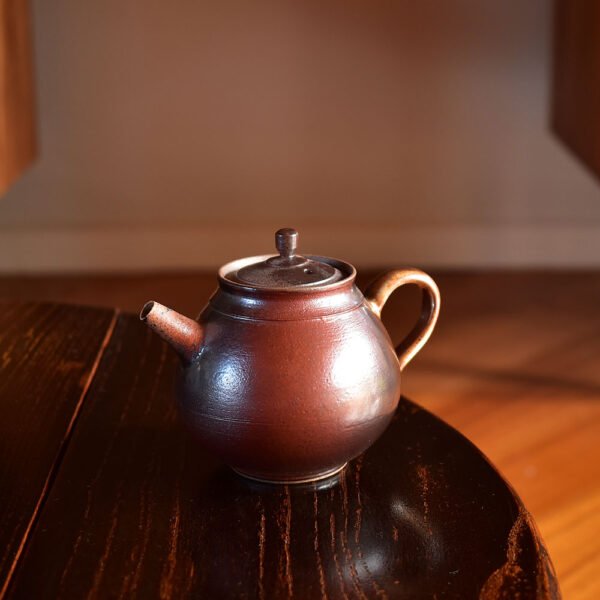
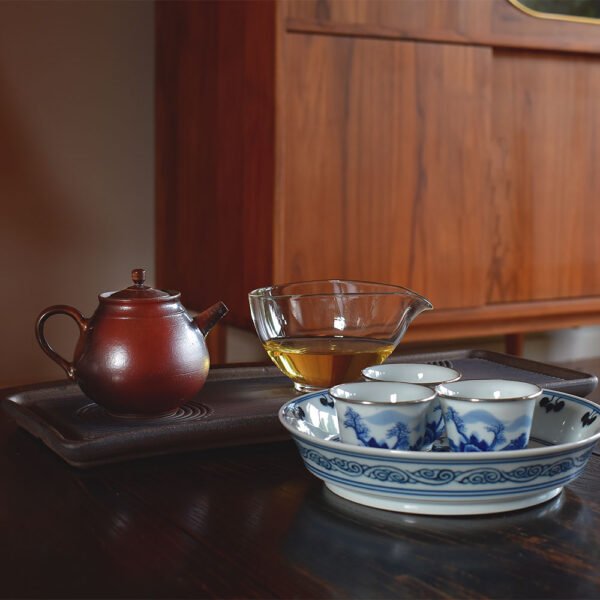 Out of Stock$123.99[vc_row et_row_padding="true" el_class="p-variations"][vc_column width="1/3" offset="vc_col-xs-4"][et_image alignment="aligncenter" image="29756" img_link="url:%2Fp%2Fhandmade-wood-fired-beauty-teapot-round%2F"][/et_image][/vc_column][vc_column width="1/3" offset="vc_col-xs-4"][et_image alignment="aligncenter" image="29750" extra_class="p-current"][/et_image][/vc_column][vc_column width="1/3" offset="vc_col-xs-4"][/vc_column][/vc_row]
Out of Stock$123.99[vc_row et_row_padding="true" el_class="p-variations"][vc_column width="1/3" offset="vc_col-xs-4"][et_image alignment="aligncenter" image="29756" img_link="url:%2Fp%2Fhandmade-wood-fired-beauty-teapot-round%2F"][/et_image][/vc_column][vc_column width="1/3" offset="vc_col-xs-4"][et_image alignment="aligncenter" image="29750" extra_class="p-current"][/et_image][/vc_column][vc_column width="1/3" offset="vc_col-xs-4"][/vc_column][/vc_row]Stoneware clay wood-fired teapots are handcrafted, which means that each piece is unique. And it has a unique beauty that comes from both the nature of the materials used and the firing process.
Stoneware clay is a type of ceramic clay that has a naturally earthy and organic appearance. It is often chosen by potters for its ability to give a warm and rustic feel to their work. When combined with the natural effects of wood-firing, the teapot can have a very distinct and beautiful appearance.
This unique teapot can be an impressive beauty and enjoyment when experiencing tea tasting ceremony.
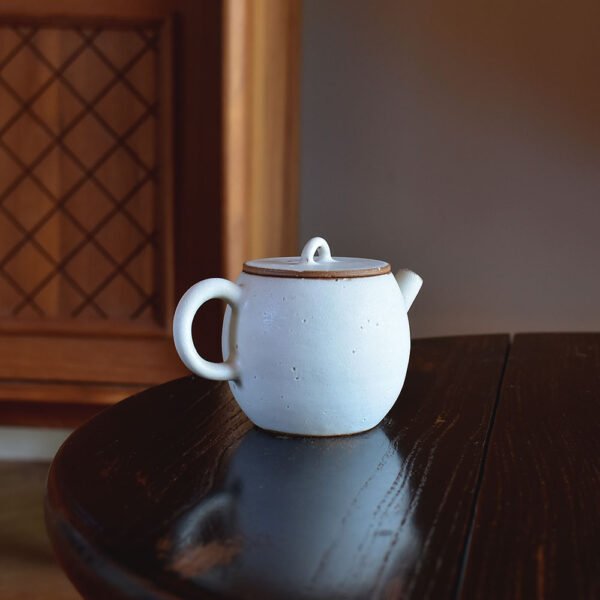
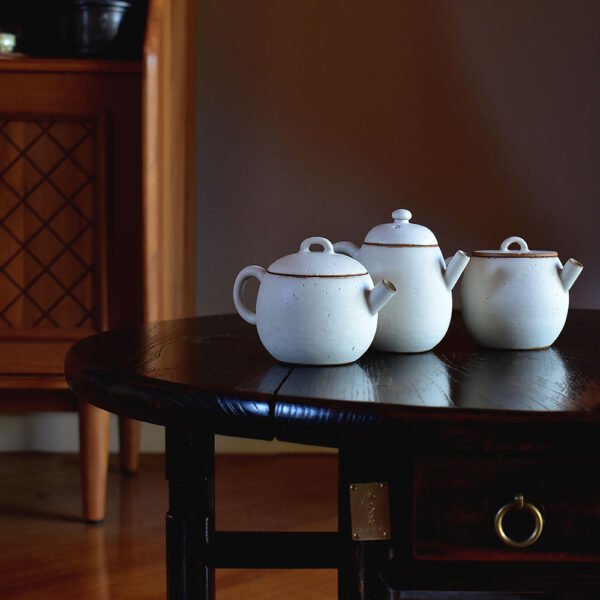 Out of Stock$149.99[vc_row et_row_padding="true" el_class="p-variations"][vc_column width="1/3" offset="vc_col-xs-4"][et_image alignment="aligncenter" image="29663" img_link="url:%2Fp%2Fstoneware-clay-powder-sprinkling-small-teapot-tall%2F"][/et_image][/vc_column][vc_column width="1/3" offset="vc_col-xs-4"][et_image alignment="aligncenter" image="29660" extra_class="p-current"][/et_image][/vc_column][vc_column width="1/3" offset="vc_col-xs-4"][et_image alignment="aligncenter" image="29657" img_link="url:%2Fp%2Fstoneware-clay-powder-sprinkling-small-teapot-short%2F"][/et_image][/vc_column][/vc_row]
Out of Stock$149.99[vc_row et_row_padding="true" el_class="p-variations"][vc_column width="1/3" offset="vc_col-xs-4"][et_image alignment="aligncenter" image="29663" img_link="url:%2Fp%2Fstoneware-clay-powder-sprinkling-small-teapot-tall%2F"][/et_image][/vc_column][vc_column width="1/3" offset="vc_col-xs-4"][et_image alignment="aligncenter" image="29660" extra_class="p-current"][/et_image][/vc_column][vc_column width="1/3" offset="vc_col-xs-4"][et_image alignment="aligncenter" image="29657" img_link="url:%2Fp%2Fstoneware-clay-powder-sprinkling-small-teapot-short%2F"][/et_image][/vc_column][/vc_row]This stoneware clay powder sprinkling teapot is entirely handmade. Its appearance presents a rough feeling which is its own unique beauty.
Its special technique -powder sprinkling (‘Fenyin’ in Chinese) also known as “powder blowing”, is named after its appearance resembling a gust of powder blown up by the wind. The characteristic of powder sprinkling is that the traces of its past use gradually change over time. The surface of powder sprinkling has many pores, and once water enters, those traces will unfold like petals. Rustic, understated, and inclusive, these are its features of it. Placed on a tea table, it always exudes a light sense of tranquillity and warmth.
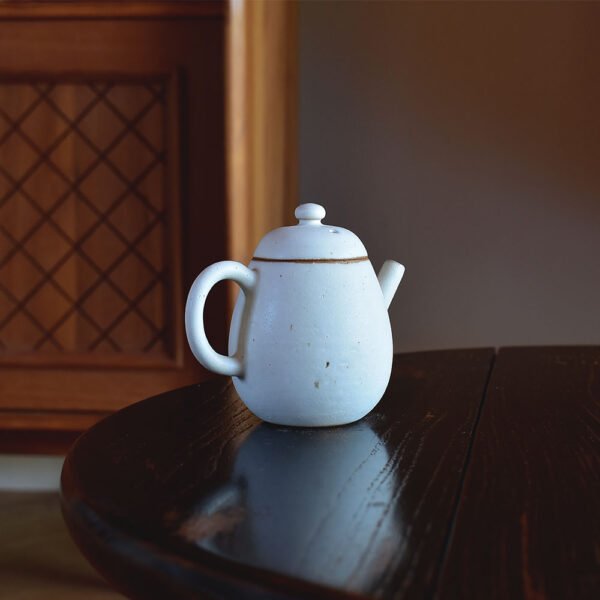
 Out of Stock$149.99[vc_row et_row_padding="true" el_class="p-variations"][vc_column width="1/3" offset="vc_col-xs-4"][et_image alignment="aligncenter" image="29663" extra_class="p-current"][/et_image][/vc_column][vc_column width="1/3" offset="vc_col-xs-4"][et_image alignment="aligncenter" image="29660" img_link="url:%2Fp%2Fstoneware-clay-powder-sprinkling-small-teapot-flat%2F"][/et_image][/vc_column][vc_column width="1/3" offset="vc_col-xs-4"][et_image alignment="aligncenter" image="29657" img_link="url:%2Fp%2Fstoneware-clay-powder-sprinkling-small-teapot-short%2F"][/et_image][/vc_column][/vc_row]
Out of Stock$149.99[vc_row et_row_padding="true" el_class="p-variations"][vc_column width="1/3" offset="vc_col-xs-4"][et_image alignment="aligncenter" image="29663" extra_class="p-current"][/et_image][/vc_column][vc_column width="1/3" offset="vc_col-xs-4"][et_image alignment="aligncenter" image="29660" img_link="url:%2Fp%2Fstoneware-clay-powder-sprinkling-small-teapot-flat%2F"][/et_image][/vc_column][vc_column width="1/3" offset="vc_col-xs-4"][et_image alignment="aligncenter" image="29657" img_link="url:%2Fp%2Fstoneware-clay-powder-sprinkling-small-teapot-short%2F"][/et_image][/vc_column][/vc_row]This stoneware clay powder sprinkling teapot is entirely handmade. Its appearance presents a rough feeling which is its own unique beauty.
Its special technique -powder sprinkling (‘Fenyin’ in Chinese) also known as “powder blowing”, is named after its appearance resembling a gust of powder blown up by the wind. The characteristic of powder sprinkling is that the traces of its past use gradually change over time. The surface of powder sprinkling has many pores, and once water enters, those traces will unfold like petals. Rustic, understated, and inclusive, these are its features of it. Placed on a tea table, it always exudes a light sense of tranquillity and warmth.
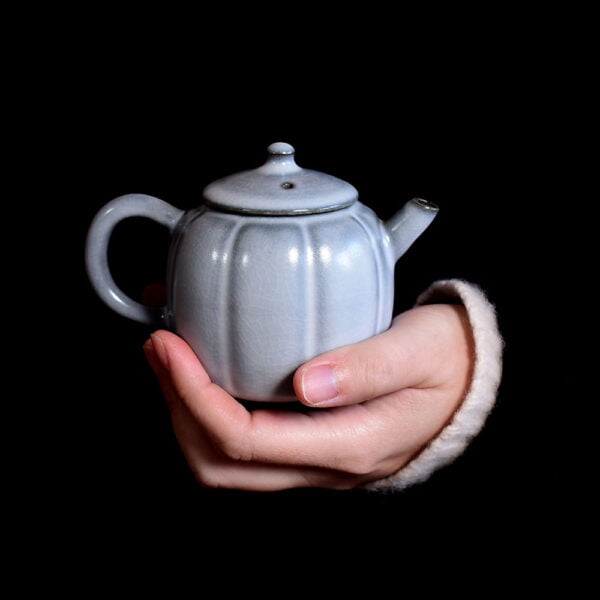
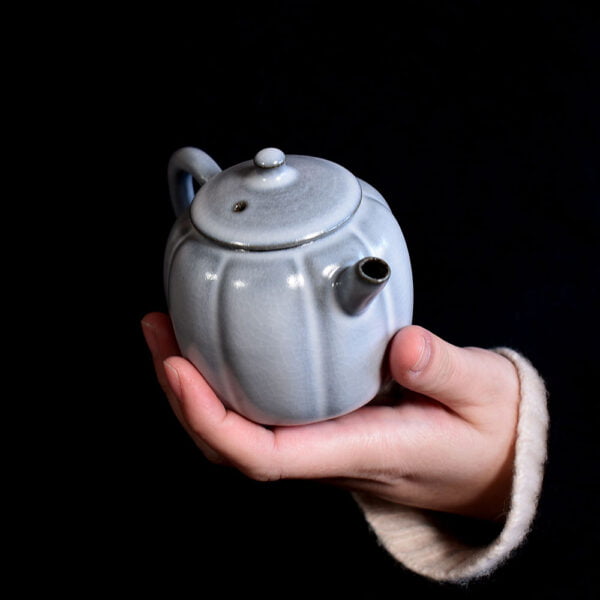 $439.99
$439.99This teapot is made with special Lao Yan Mud as the material, both inside and outside covered with soda ash glaze, and semi-handmade. Its elegant shape and smooth water flow make it an excellent companion for tea drinking. The unique cracked glaze technique creates beautiful patterns on the surface as the cracks are formed by the long-term infusion of tea. Generally, the patterns created through the cracked glaze technique are unique, adding more enjoyment to the tea brewing process.
Its special clay material, Lao Yan Mud, possesses irreplaceable advantages over other clay materials for teapot making. Lao Yan Mud is formulated by blending rock minerals and clay. The mineral components (such as quartz, mica, etc) in the clay do not melt at temperatures around 1250 degrees Celsius, resulting in the formation of voids during the firing and drying process. These irregular pores, formed due to different shrinkage rates during the final firing, do not fully vitrify. These porous structures contribute to preserving and enhancing the aroma and character of the tea, allowing the water to become fragrant and sweet when brewed.
Besides the special mud, soda glaze is another main character of this tea pot. The soda glaze is crafted using imported raw minerals from Japan, where, through high-temperature firing, weak alkaline metal ions such as potassium, sodium, and calcium are released and incorporated into the glaze. The surface of the teapot bears tiny pores left behind by the firing process of the natural raw minerals. These breathable pores possess the unique ability to adsorb tea impurities, reduce bitterness, and maintain a refreshing, non-stuffy character, greatly enhancing the quality of the tea infusion. The result is a smoother, more delicate, and pleasantly aromatic tea experience. Upon heating with boiling water, the trace elements like boron, zinc, and lithium, found within the soda glaze, significantly soften the water quality. This effect causes the water molecules to exhibit a weak alkaline state, a characteristic not typically found in ordinary boiling vessels. This outstanding property has earned it the industry nickname – ‘the balance of regulating the body’s acid-alkaline equilibrium.’ Prolonged use of the soda-glazed miniature teapot proves highly beneficial for one’s health.
This teapot has a simple, rustic appearance and smooth water flow. Due to the spongy pores of the Lao Yan mud which makes it can absorb the fragrance of the tea leaves, the aroma of the tea soup can easily maintain for a longer time and taste smoother and sweeter.
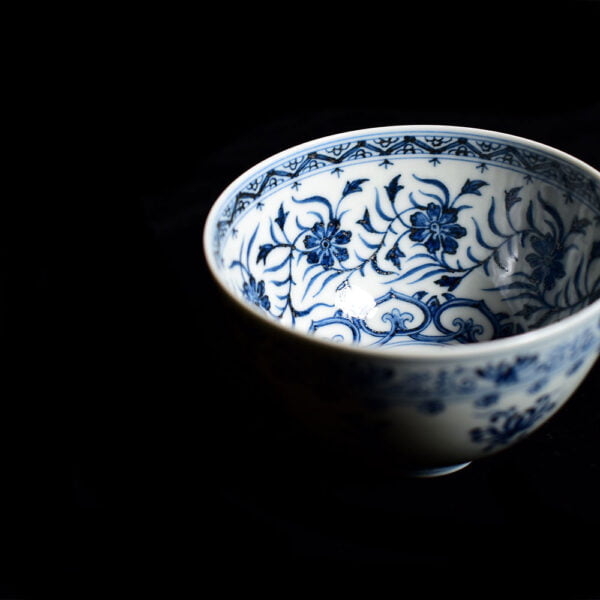
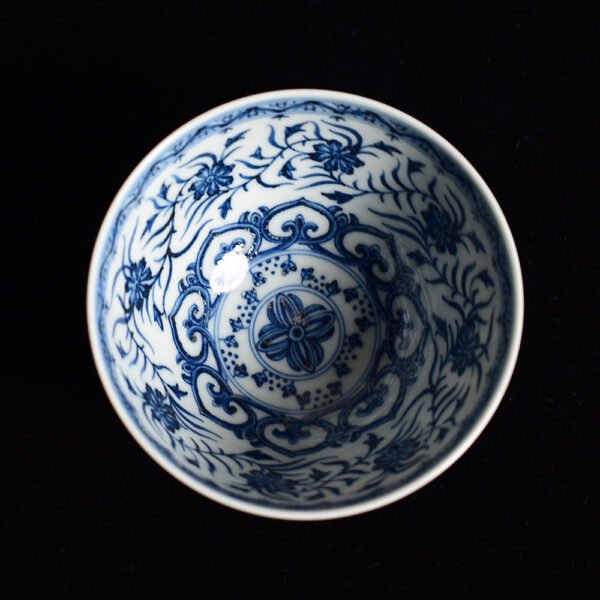 $645.99
$645.99The style of this super beautiful teacup is Ming, using the underglaze blue technique, and entirely handcrafted and hand painted.
This cup is adorned with intricate blue and white patterns of interwoven branches and miscellaneous treasures (Za Bao in Chinese) on the outer wall, with a lotus petal pattern encircling the base. The interior of the cup is fully covered in blue and white patterns of Baoxiang flowers and Ruyi motifs, creating an overall design that is rich and detailed, with smooth and flowing lines. The blue and white colours are deep and elegant, with a white glaze featuring subtle flashes of blue. The glaze surface is glossy, and the texture is smooth. The cup has a lightweight and elegant shape, achieving a harmonious balance between practicality and aesthetics. At the bottom, there is a chicken-heart-shaped protrusion, hence the name ‘chicken-heart teacup’.
In ancient China, the intertwined branch pattern represented the concept of endless growth and lasting wealth and prosperity, symbolizing longevity, and prosperity. And the miscellaneous treasures (Za Bao in Chinese) pattern symbolizes various decorative motifs that bring good luck and auspiciousness. Due to the absence of a fixed number and combination of elements, it is commonly known as the “miscellaneous treasures” pattern. The miscellaneous treasures pattern encompasses the common aspirations of society for power, wealth, love, happiness, longevity, and pleasure, making it a popular and cherished design in folk art.
The Baoxiang flowers inside the cup symbolize good luck, harmony, happiness, and prosperity. The Ruyi motif’s auspiciousness, combining profound meaning with graceful form, represents the auspicious, favourable implications.
In addition, the beautiful tin spots on the porcelain add even more unique charm to it. The formation of tin spots is due to the high content of iron elements in local parts of the blue pigment. After reaching saturation in the high-temperature glaze solution and cooling down, the iron elements in the supersaturated part start to precipitate. If the iron content of the blue pigment is higher and the cooling rate is appropriate, tin spots are more likely to appear on the surface of the ware.
In addition to firing and materials, the formation of tin spots also involves the factor of glaze material. During the painting process, tin spots can also be formed due to the accumulation of blue pigment. Tin spots are more likely to appear on the surface of the ware at the intersections and the starting and ending points of brushstrokes. The formation of tin spots can be said to be a natural creation or an artificial decoration. This tin glazes not only add a rustic texture to the teacup but also imbue it with a unique sense of history.
The body of this teacup is smooth and well-lubricated, while the underglaze blue patterns are vivid and lifelike. The faint tin specks add a touch of charm from a bygone era, evoking a sense of nostalgia and natural beauty, making it exquisitely graceful. Each stroke of the underglaze blue decoration is delicate and captivating, bringing the design to life. The intricate and refined patterns showcase the artist’s profound artistic skills.
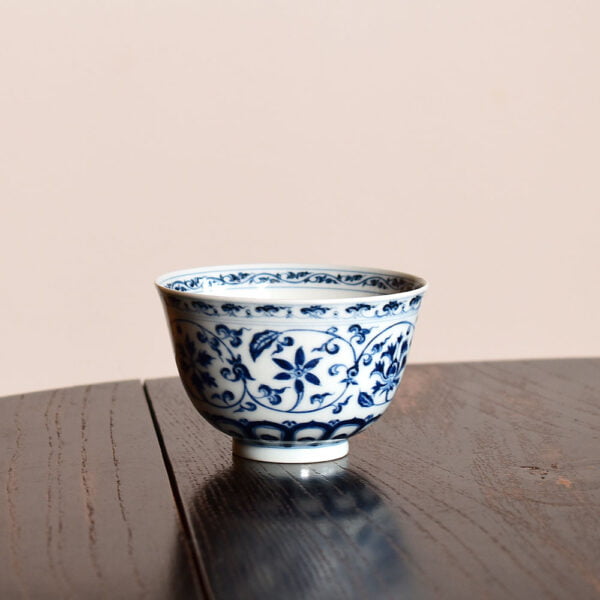
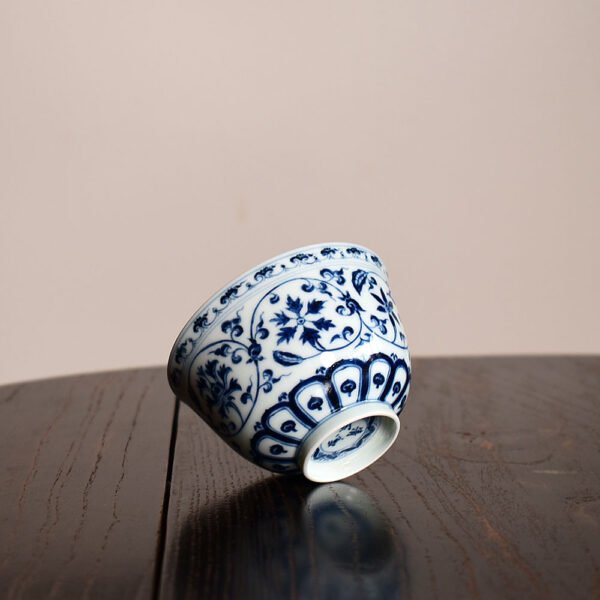 $515.99
$515.99The style of this super beautiful teacup is Ming, using the underglaze blue technique, and entirely handcrafted and hand painted. The pattern features the classic design of intertwining lotus branches (Chanzhi Lian).
Chanzhi Lian, also known as ‘intertwining lotus branches’ or ‘Interlock Branch Lotus’, is a Chinese decorative motif with the symbolism of “flowers within flowers, blossoms within leaves.” It is also referred to as the “Wanshou Teng,” representing auspiciousness and longevity due to its continuous and interconnected structure, symbolizing the concept of “endless vitality.” In addition, in traditional Chinese Confucian culture, the lotus is seen as the embodiment of truth, goodness, and beauty, as well as a symbol of Buddhism. The pronunciation of “Lian” is similar to the word “continuous” in Chinese, further expressing the idea of continuous growth and conveying positive wishes and emotions.
As part of Chinese traditional ornamentation, Chanzhi Lian has been passed down through generations, reflecting its own beauty and cultural significance with a unique artistic charm. The lotus possesses a sacred and pure temperament, being beautiful without being ostentatious and magnificent without being vulgar. It is precisely because of this aesthetic appeal that Chanzhi Lian has become a decorative pattern applied to various aspects of life.
In addition, the beautiful tin spots on the porcelain add even more unique charm to it. The formation of tin spots is due to the high content of iron elements in local parts of the blue pigment. After reaching saturation in the high-temperature glaze solution and cooling down, the iron elements in the supersaturated part start to precipitate. If the iron content of the blue pigment is higher and the cooling rate is appropriate, tin spots are more likely to appear on the surface of the ware.
In addition to firing and materials, the formation of tin spots also involves the factor of glaze material. During the painting process, tin spots can also be formed due to the accumulation of blue pigment. Tin spots are more likely to appear on the surface of the ware at the intersections and the starting and ending points of brushstrokes. The formation of tin spots can be said to be a natural creation or an artificial decoration. This tin glazes not only add a rustic texture to the teacup but also imbue it with a unique sense of history.
The delicate brushstrokes and intricate detailing of the painting on this teacup create a distinct sense of aesthetic appeal. The soft and elegant shade of underglaze blue, along with a hint of faint tin glaze, gives it a graceful and ethereal beauty under the light. This teacup exudes a simple yet elegant charm, reminiscent of the style of imitation Ming, making it truly captivating and irresistible.
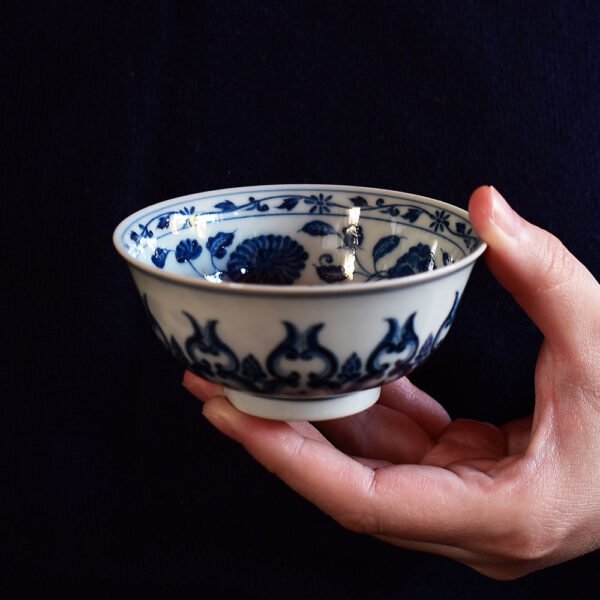
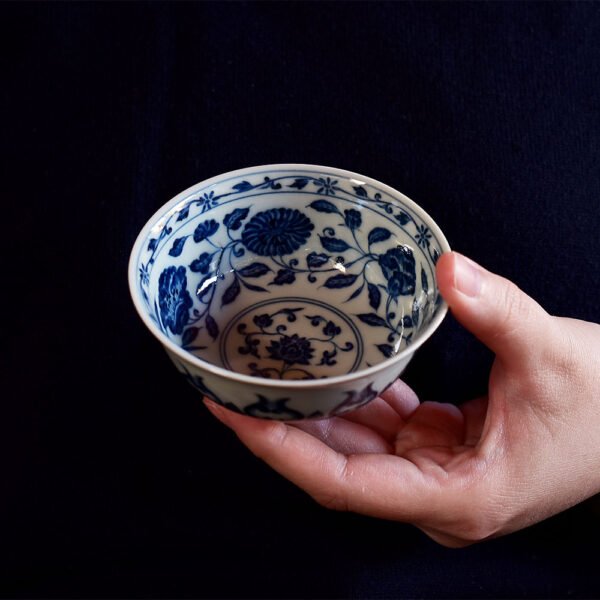 $645.99
$645.99The style of this super beautiful teacup is Ming, using the underglaze blue technique, and entirely handcrafted and hand painted. The pattern on the body of the teacup showcases the traditional Chinese twin lotus motif.
In addition, the beautiful tin spots on the porcelain add even more unique charm to it. The formation of tin spots is due to the high content of iron elements in local parts of the blue pigment. After reaching saturation in the high-temperature glaze solution and cooling down, the iron elements in the supersaturated part start to precipitate. If the iron content of the blue pigment is higher and the cooling rate is appropriate, tin spots are more likely to appear on the surface of the ware.
In addition to firing and materials, the formation of tin spots also involves the factor of glaze material. During the painting process, tin spots can also be formed due to the accumulation of blue pigment. Tin spots are more likely to appear on the surface of the ware at the intersections and the starting and ending points of brushstrokes. The formation of tin spots can be said to be a natural creation or an artificial decoration. This tin glazes not only add a rustic texture to the teacup but also imbue it with a unique sense of history.
The delicate brushstrokes and intricate detailing of the painting on this teacup create a distinct sense of aesthetic appeal. The soft and elegant shade of underglaze blue, along with a hint of faint tin glaze, gives it a graceful and ethereal beauty under the light. This teacup exudes a simple yet elegant charm, reminiscent of the style of imitation Ming, making it truly captivating and irresistible.
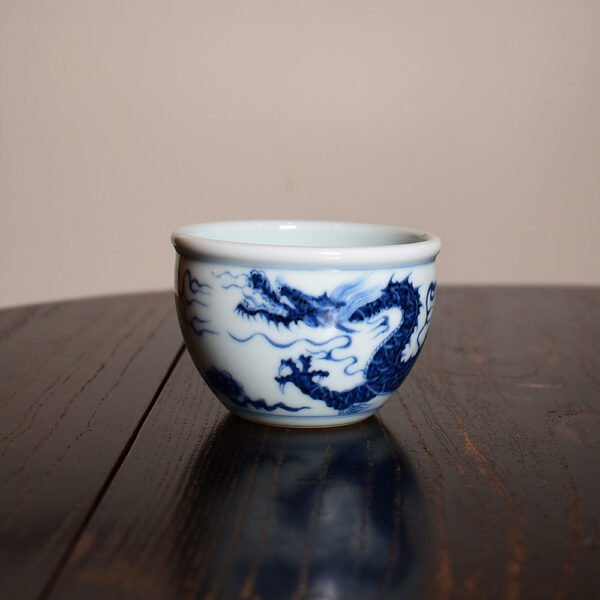
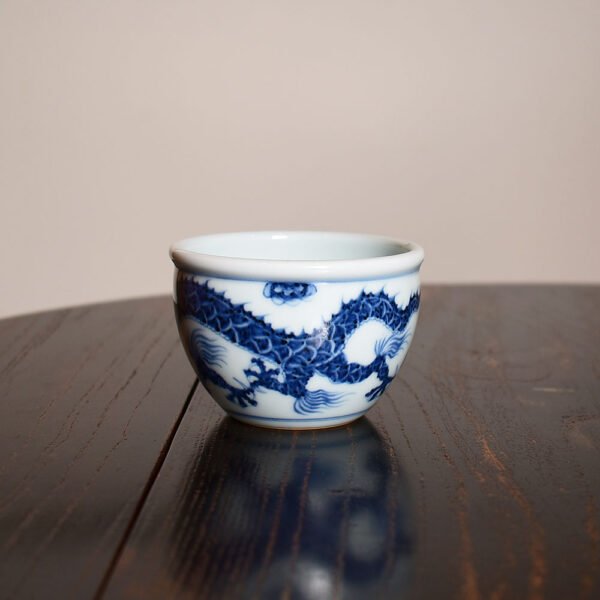 $439.99
$439.99This master teacup is made in the style of the Yuan dynasty blue and white porcelain, completely handmade and hand-painted. The entire painting exudes a strong sense of antiquity, with bold and vigorous lines, and the dragon pattern appears vivid and lifelike.
In Chinese culture, the dragon is a very important symbol and totem with rich symbolism. Firstly, the dragon is one of the most sacred, authoritative, and noble images in ancient Chinese culture. It is the incarnation of the gods of heaven, earth, and water, representing supreme authority and divine power. Secondly, the dragon is considered a symbol of good luck in Chinese culture. As it has the special power to control rainfall, it is also seen as the protector of agriculture, representing a bountiful harvest and prosperity. Additionally, the dragon has many other symbolic meanings, such as longevity, authority, success, courage, and wisdom. In traditional Chinese culture, the dragon is a noble, mysterious, and awe-inspiring image, representing people’s yearning for the unknown and the spirit of exploration.
Besides, for Yuan blue and white porcelain refers to the blue and white porcelain produced during the Yuan dynasty (1271-1368) in China. The Yuan dynasty was an important period in the history of Chinese porcelain and one of the peaks of Chinese porcelain art. As one of the representatives of that era, Yuan blue and white porcelain exhibited unique artistic styles and technical levels. The characteristic of Yuan blue and white is the use of cobalt blue pigment for painting, which is made of cobalt oxide. After firing, the colour is bright and rich, with an extremely high decorative effect. Yuan blue and white porcelain has various shapes, thick and heavy, concise, and fluent lines, and stable and solemn shapes, all made exquisitely.
The evolution of Yuan blue and white is based on the foundation of the Tang and Song celadon. Firstly, the glaze colour was improved and innovated. Unique white glaze, eggshell glaze, and blue-white glaze were invented to make the glaze crystal clear. Cobalt pigment was imported for glaze colouring. Or using pigment made from domestic materials.
The formation of tin spots on Yuan blue and white is due to the high content of iron elements in local parts of the blue pigment. After reaching saturation in the high-temperature glaze solution and cooling down, the iron elements in the supersaturated part start to precipitate. If the iron content of the blue pigment is higher and the cooling rate is appropriate, tin spots are more likely to appear on the surface of the ware.
In addition to firing and materials, the formation of tin spots also involves the factor of glaze material. During the painting process, tin spots can also be formed due to the accumulation of blue pigment. Tin spots are more likely to appear on the surface of the ware at the intersections and the starting and ending points of brushstrokes. The formation of tin spots can be said to be a natural creation or an artificial decoration.
This master teacup has a smooth and lustrous texture and uses the Su Ma Li Qing glaze material (a kind of blue pigment), with a heavy sense of tin spots, revealing a unique charm of the past era. The entire production process is completed by hand, and every detail has been carefully designed and polished, giving this teacup a unique artistic charm. The blue and white dragon pattern is vivid, showcasing ancient cultural and aesthetic values, allowing people to immerse themselves in a beautiful artistic atmosphere while enjoying their tea.
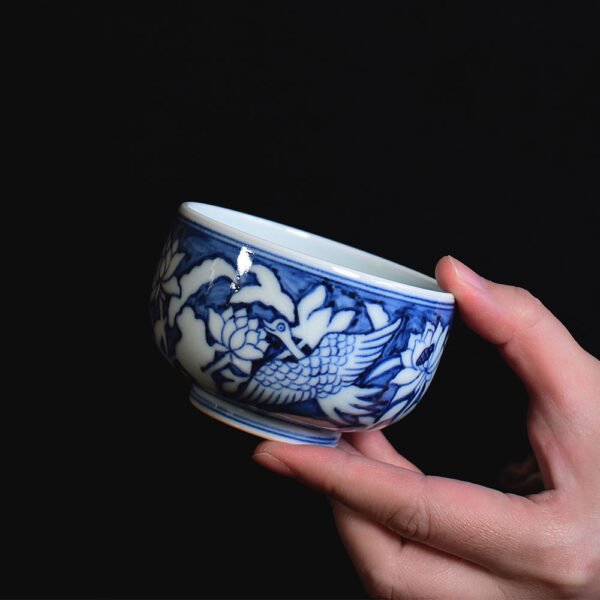
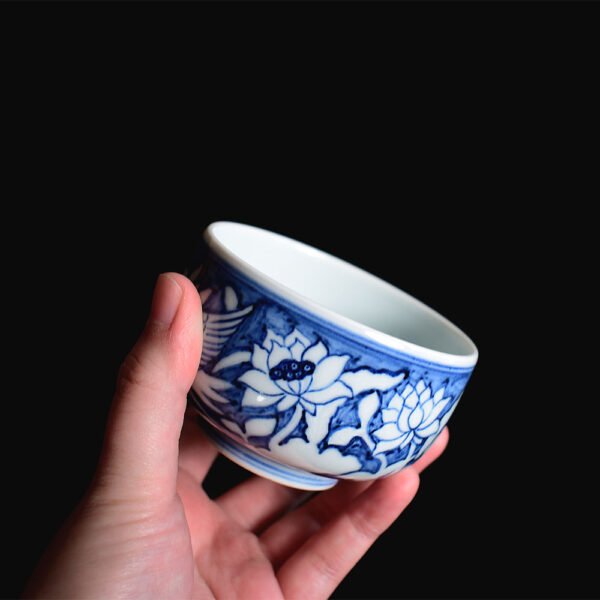 $439.99
$439.99This arhat teacup is made in the style of the Yuan dynasty blue and white porcelain, completely handmade and hand painted. The pattern of “一鹭莲科” or “一路连科” in Chinese culture is derived from the beautiful combination of the heron and lotus leaves. As “鹭” (heron) and “路” (path/road) have the same pronunciation, and “莲” (lotus) sounds like “连” (successive/continuous), the name “一路连科” is a play on words that conveys the beautiful meaning of the pattern. In ancient times, successive successful candidates in the imperial examinations were called “连科,” and “一路连科” is a good wish for students to have a smooth career path and achieve success step by step.
This teacup has a thick body and uses the Su Ma Li Qing glaze material (a kind of blue pigment) which reveals a unique charm of the past era. The entire production process is completed by hand, and every detail has been carefully designed and polished, giving this teacup a unique artistic charm.
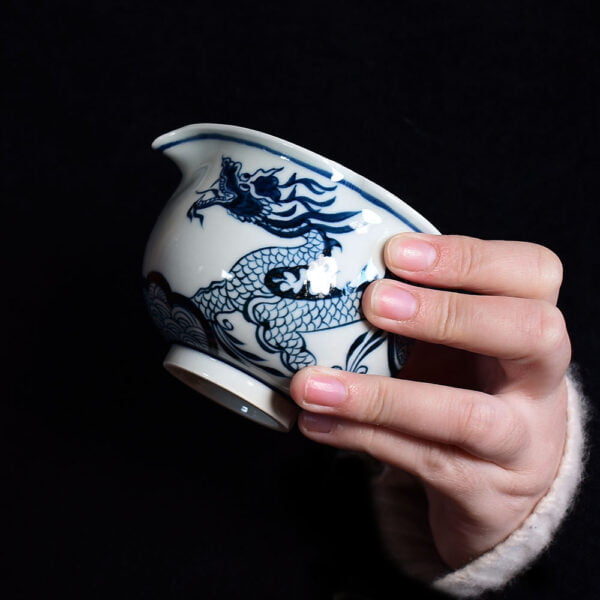
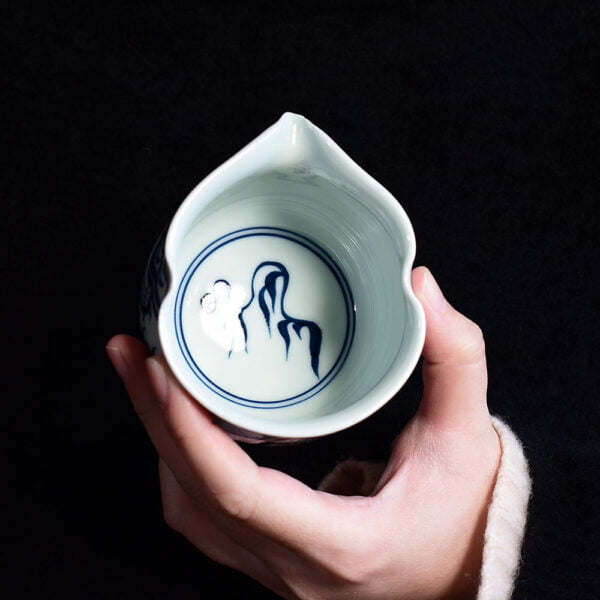 Out of Stock$195.99
Out of Stock$195.99In Chinese culture, the dragon is a very important symbol and totem with rich symbolism. Firstly, the dragon is one of the most sacred, authoritative, and noble images in ancient Chinese culture. It is the incarnation of the gods of heaven, earth, and water, representing supreme authority and divine power. Secondly, the dragon is considered a symbol of good luck in Chinese culture. As it has the special power to control rainfall, it is also seen as the protector of agriculture, representing a bountiful harvest and prosperity. Additionally, the dragon has many other symbolic meanings, such as longevity, authority, success, courage, and wisdom. In traditional Chinese culture, the dragon is a noble, mysterious, and awe-inspiring image, representing people’s yearning for the unknown and the spirit of exploration.
This fair cup is made in the style of the Yuan dynasty blue and white porcelain, completely handmade and hand-painted. The blue and white dragon pattern is vivid, showcasing ancient cultural and aesthetic values, allowing people to immerse themselves in a beautiful artistic atmosphere while enjoying their tea.
For Yuan blue and white porcelain refers to the blue and white porcelain produced during the Yuan dynasty (1271-1368) in China. The Yuan dynasty was an important period in the history of Chinese porcelain and one of the peaks of Chinese porcelain art. As one of the representatives of that era, Yuan blue and white porcelain exhibited unique artistic styles and technical levels. The characteristic of Yuan blue and white is the use of cobalt blue pigment for painting, which is made of cobalt oxide. After firing, the colour is bright and rich, with an extremely high decorative effect. Yuan blue and white porcelain has various shapes, thick and heavy, concise, and fluent lines, and stable and solemn shapes, all made exquisitely.
The evolution of Yuan blue and white is based on the foundation of the Tang and Song celadon. Firstly, the glaze colour was improved and innovated. Unique white glaze, eggshell glaze, and blue-white glaze were invented to make the glaze crystal clear. Cobalt pigment was imported for glaze colouring. Or using pigment made from domestic materials.
The formation of tin spots on Yuan blue and white is due to the high content of iron elements in local parts of the blue pigment. After reaching saturation in the high-temperature glaze solution and cooling down, the iron elements in the supersaturated part start to precipitate. If the iron content of the blue pigment is higher and the cooling rate is appropriate, tin spots are more likely to appear on the surface of the ware.
In addition to firing and materials, the formation of tin spots also involves the factor of glaze material. During the painting process, tin spots can also be formed due to the accumulation of blue pigment. Tin spots are more likely to appear on the surface of the ware at the intersections and the starting and ending points of brushstrokes. The formation of tin spots can be said to be a natural creation or an artificial decoration.
This fair cup has a thick body and uses the Su Ma Li Qing glaze material (a kind of blue pigment), with a heavy sense of tin spots, revealing a unique charm of the past era. The entire production process is completed by hand, and every detail has been carefully designed and polished, giving this teacup a unique artistic charm. The blue and white dragon pattern is vivid, showcasing ancient cultural and aesthetic values, allowing people to immerse themselves in a beautiful artistic atmosphere while enjoying their tea.
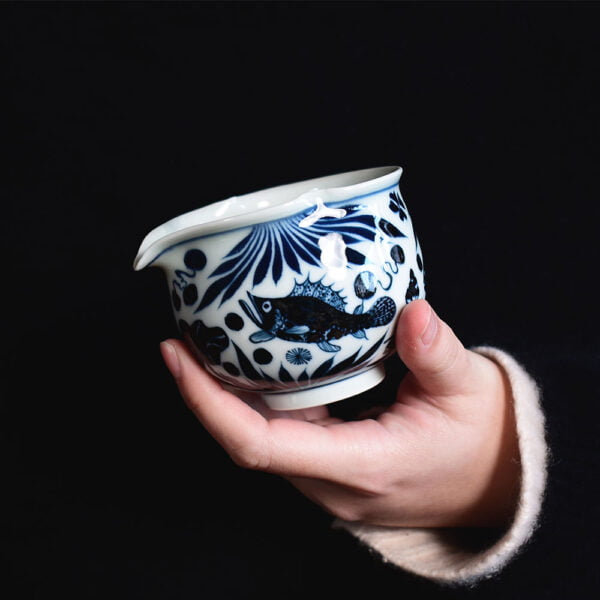
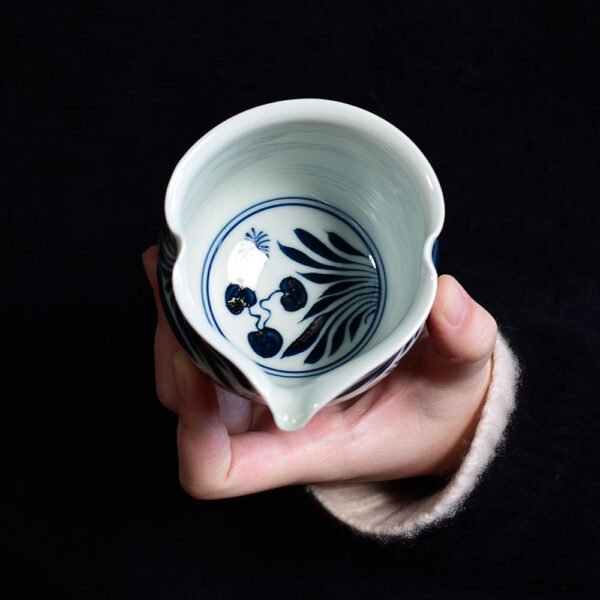 Out of Stock$195.99
Out of Stock$195.99This fair cup is made in the style of the Yuan dynasty blue and white porcelain, completely handmade and hand-painted. The blue and white fish & seaweed pattern is vivid, showcasing ancient cultural and aesthetic values, allowing people to immerse themselves in a beautiful artistic atmosphere while enjoying their tea.
The special pattern of this teacup is fish and seaweed. Since ancient times, fish and seaweed motifs have been traditional decorative patterns in ceramics, representing auspiciousness and carrying rich cultural and aesthetic meanings. The homophonic association between fish and the Chinese word for “surplus” (yu) makes fish a symbol of abundance and wealth. Fish motifs are often used to convey the meaning of “abundance and surplus,” “prosperity year after year” (as the pronunciation of fish is similar to that of “surplus” in Chinese), and “auspicious celebrations and abundance.” The fish and seaweed motifs typically feature fish as the central element, with additional decorations such as water plants, forming a variety of decorative patterns. The depiction of four swimming fish in the artwork symbolizes the concept of “surplus in all four seasons,” representing a year-round surplus, which carries a highly positive connotation. Such motifs are not only favoured by the royal court but also beloved by people from all walks of life as auspicious decorations. The flexible composition, auspicious symbolism, and abundant variations of fish and seaweed motifs have made them timeless classics throughout different eras.
For Yuan blue and white porcelain refers to the blue and white porcelain produced during the Yuan dynasty (1271-1368) in China. The Yuan dynasty was an important period in the history of Chinese porcelain and one of the peaks of Chinese porcelain art. As one of the representatives of that era, Yuan blue and white porcelain exhibited unique artistic styles and technical levels. The characteristic of Yuan blue and white is the use of cobalt blue pigment for painting, which is made of cobalt oxide. After firing, the colour is bright and rich, with an extremely high decorative effect. Yuan blue and white porcelain has various shapes, thick and heavy, concise, and fluent lines, and stable and solemn shapes, all made exquisitely.
The evolution of Yuan blue and white is based on the foundation of the Tang and Song celadon. Firstly, the glaze colour was improved and innovated. Unique white glaze, eggshell glaze and blue-white glaze were invented to make the glaze crystal clear. Cobalt pigment was imported for glaze colouring. Or using pigment made from domestic materials.
The formation of tin spots on Yuan blue and white is due to the high content of iron elements in local parts of the blue pigment. After reaching saturation in the high-temperature glaze solution and cooling down, the iron elements in the supersaturated part start to precipitate. If the iron content of the blue pigment is higher and the cooling rate is appropriate, tin spots are more likely to appear on the surface of the ware.
In addition to firing and materials, the formation of tin spots also involves the factor of glaze material. During the painting process, tin spots can also be formed due to the accumulation of blue pigment. Tin spots are more likely to appear on the surface of the ware at the intersections and the starting and ending points of brushstrokes. The formation of tin spots can be said to be a natural creation or an artificial decoration.
This fair cup has a thick body and uses the Su Ma Li Qing glaze material (a kind of blue pigment), with a heavy sense of tin spots, revealing a unique charm of the past era. The entire production process is completed by hand, and every detail has been carefully designed and polished, giving this teacup a unique artistic charm. The blue and white fish & seaweed pattern is vivid, showcasing ancient cultural and aesthetic values, allowing people to immerse themselves in a beautiful artistic atmosphere while enjoying their tea.
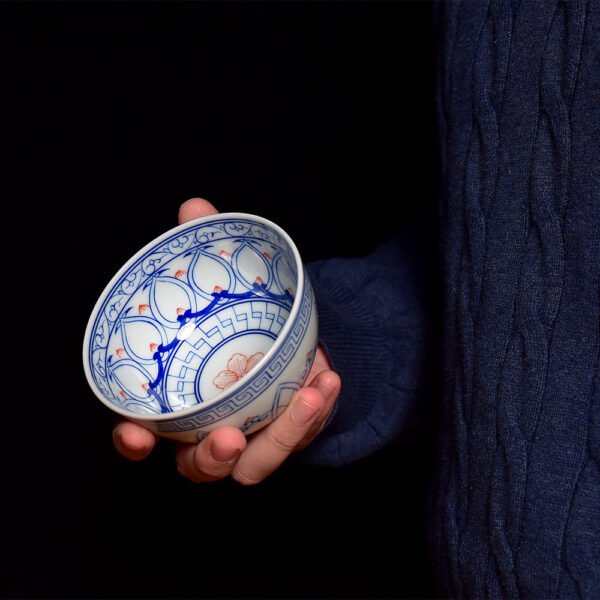
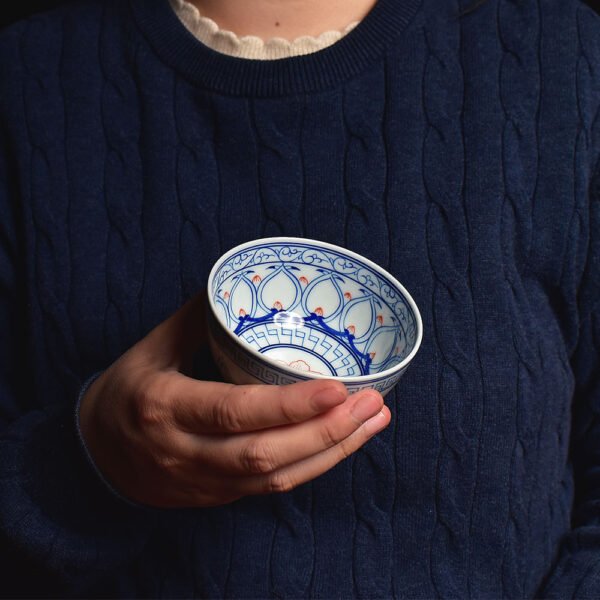 $189.99
$189.99This heart shaped teacup is completely handmade, and hand painted. The special craft used in this teaware includes Blue and white underglaze colour and underglaze red.
The pattern featured is called “Bao Xiang” in Chinese, which is a traditional decorative motif representing one of the auspicious three treasures (Bao Xiang flower, Money tree, and Treasure basin), prevalent during the Sui and Tang dynasties in China. Bao Xiang pattern is also known as ‘Bao Xian Hua’ or ‘Bao Lian Hua’. Its lines are clear, and the colour is serene and antique. The Bao Xiang pattern design of this teaware is neat, and complex but not messy, and the whole picture of it is full and rich in details.
In Chinese culture, the Bao Xiang pattern symbolizes auspiciousness and happiness, representing people’s aspirations for happiness. It is widely popular in the decoration of silk brocade, bronze mirrors, and porcelain, showcasing people’s pursuit of a better life.
This heart shaped teacup features smooth and concise curves, combining the unique beauty of Bao Xiang pattern, creating a visually appealing and enjoyable tea-drinking experience. The blue and red underglaze colours complement each other and create a beautiful radiance.
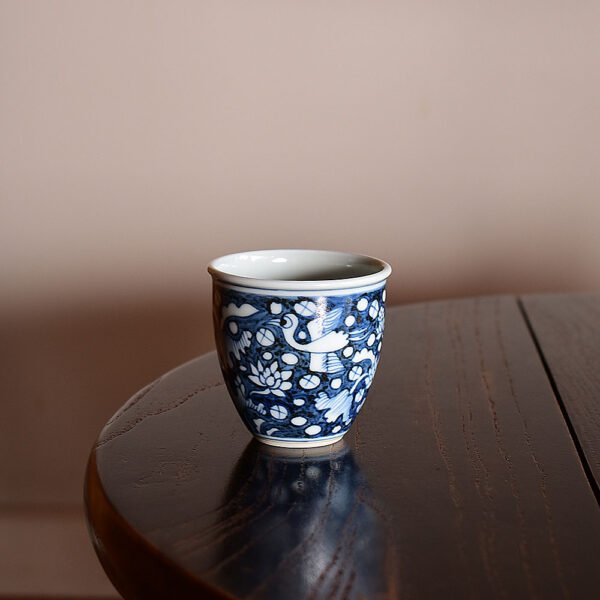
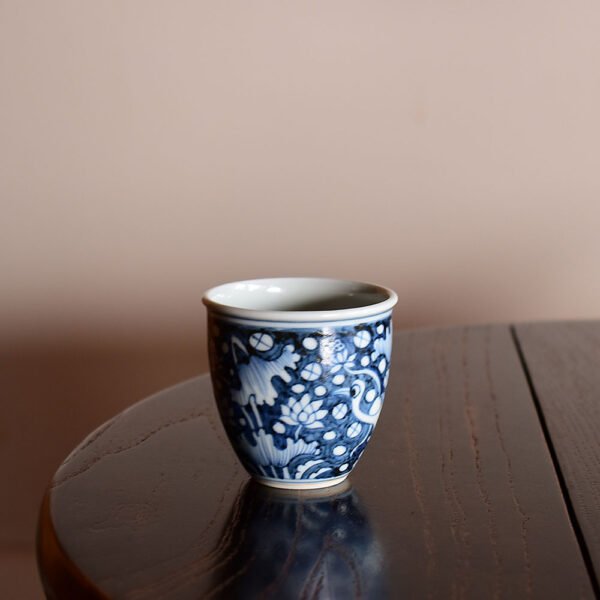 $279.99
$279.99This teacup is made in the style of the Yuan dynasty blue and white porcelain, matt glaze finish, completely handmade and hand painted. The pattern of “一鹭莲科” or “一路连科” in Chinese culture is derived from the beautiful combination of the heron and lotus leaves. As “鹭” (heron) and “路” (path/road) have the same pronunciation, and “莲” (lotus) sounds like “连” (successive/continuous), the name “一路连科” is a play on words that conveys the beautiful meaning of the pattern. In ancient times, successive successful candidates in the imperial examinations were called “连科,” and “一路连科” is a good wish for students to have a smooth career path and achieve success step by step.
For Yuan blue and white porcelain refers to the blue and white porcelain produced during the Yuan dynasty (1271-1368) in China. The Yuan dynasty was an important period in the history of Chinese porcelain and one of the peaks of Chinese porcelain art. As one of the representatives of that era, Yuan blue and white porcelain exhibited unique artistic styles and technical levels. The characteristic of Yuan blue and white is the use of cobalt blue pigment for painting, which is made of cobalt oxide. After firing, the colour is bright and rich, with extremely high decorative effect. Yuan blue and white porcelain has various shapes, thick and heavy, concise, and fluent lines, and stable and solemn shapes, all made exquisitely.
The evolution of Yuan blue and white is based on the foundation of Tang and Song celadon. Firstly, the glaze colour was improved and innovated. Unique white glaze, eggshell glaze and blue-white glaze were invented to make the glaze crystal clear. Cobalt pigment was imported for glaze colouring. Or using pigment made from domestic materials.
The formation of tin spots on Yuan blue and white is due to the high content of iron elements in local parts of the blue pigment. After reaching saturation in the high-temperature glaze solution and cooling down, the iron elements in the supersaturated part start to precipitate. If the iron content of the blue pigment is higher and the cooling rate is appropriate, tin spots are more likely to appear on the surface of the ware.
In addition to firing and materials, the formation of tin spots also involves the factor of glaze material. During the painting process, tin spots can also be formed due to the accumulation of blue pigment. Tin spots are more likely to appear on the surface of the ware at the intersections and the starting and ending points of brushstrokes. The formation of tin spots can be said to be a natural creation or an artificial decoration.
This teacup is small and exquisite and uses the Su Ma Li Qing glaze material (a kind of blue pigment), with a heavy sense of tin spots, revealing a unique charm of the past era. The entire production process is completed by hand, and every detail has been carefully designed and polished, giving this teacup a unique artistic charm.
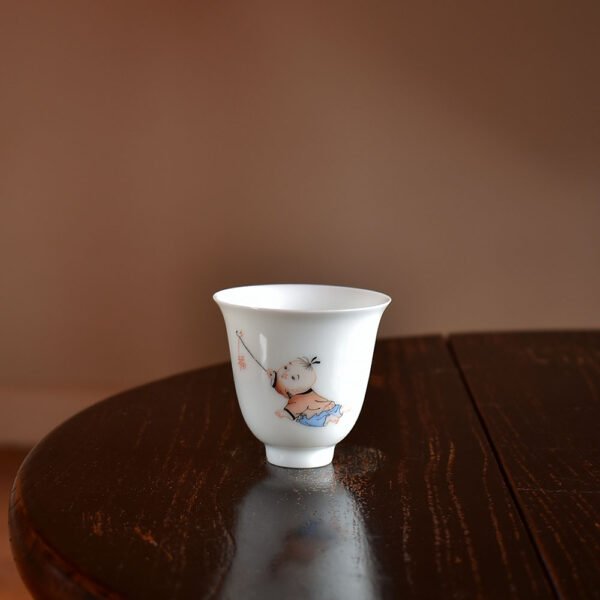
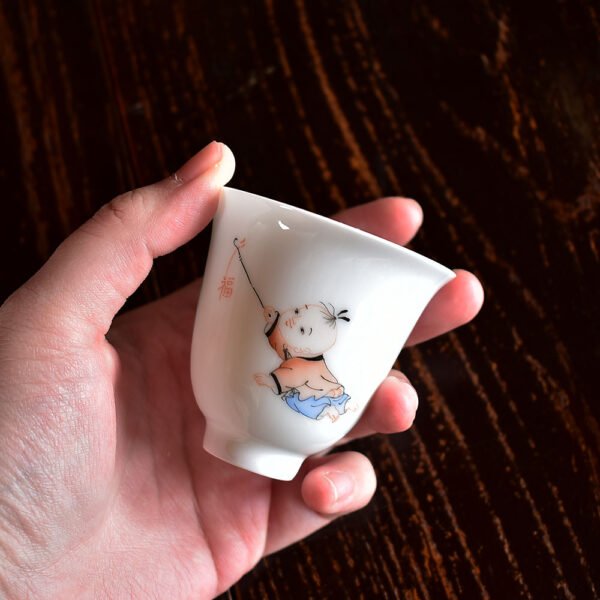 $45.99
$45.99The teacup is made from high-quality white mud, giving it a smooth and elegant texture. The surface is covered in a lovely white glaze, which creates a beautiful and glossy finish. The cup is adorned with overglaze colours in two different patterns.
One of the patterns depicts children setting off firecrackers, a symbol of celebration and joy in Chinese culture. The other pattern shows a child with good fortune, representing prosperity and good luck. Both patterns are intricate and detailed, featuring vibrant colours that contrast beautifully against the white background.
Due to being entirely hand-painted, each painting has slight differences.
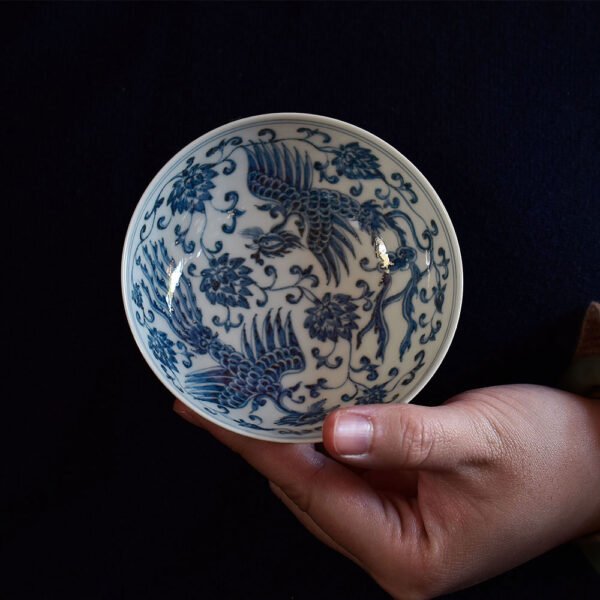
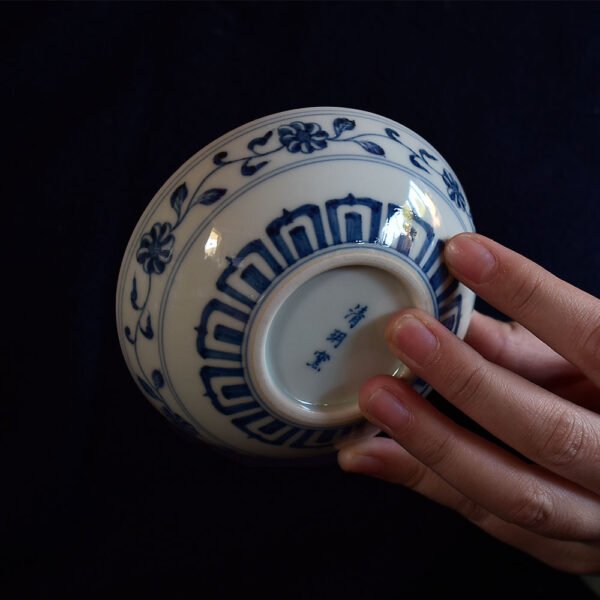 $599.99
$599.99This teacup is a replica of the imitation Ming blue and white porcelain craftsmanship, made entirely by hand. The pattern depicts a pair of phoenixes. The phoenix, known as the “Fenghuang” in Chinese, is a mythical bird considered to be the king of all birds and a symbol of auspiciousness, beauty, and grace. It represents virtue, harmony, and the union of yin and yang. When depicted as a pair, the double phoenix symbolizes the ideal relationship between a male and female. It represents the union of two exceptional individuals or the coming together of two extraordinary things. It signifies a harmonious and balanced partnership, whether in love, marriage, or any collaborative endeavour. The double phoenix is often associated with blessings, prosperity, and good fortune. It is believed to bring luck, happiness, and success, as well as symbolize marital bliss, loyalty, and everlasting love.
The texture of this teacup is delicate and smooth, and the painting is lively and lifelike. The entire production process is completed by hand, with every detail carefully designed and polished, giving this teacup a unique artistic charm.
This unique teacup replicas Ming’s tea ware style. Ming Dynasty tea wares represent the pinnacle of Chinese ceramic art, showcasing unique beauty in terms of shape, glaze colour, and decorative patterns. The imitation Ming tea wares imitate the shapes and styles of Ming Dynasty tea utensils, allowing people to appreciate the charm of traditional art and experience the flavour of history. The elegant lines, smooth curves, and delicate decorations present a sense of refined and harmonious beauty, allowing people to experience the pleasure and artistic enjoyment while tasting tea.
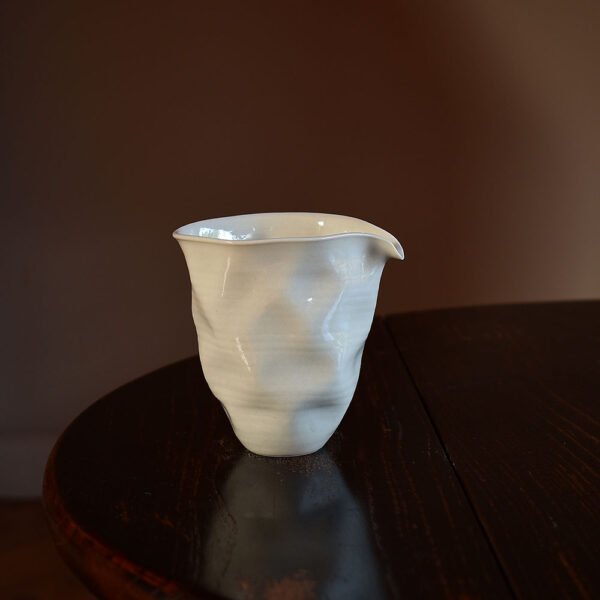
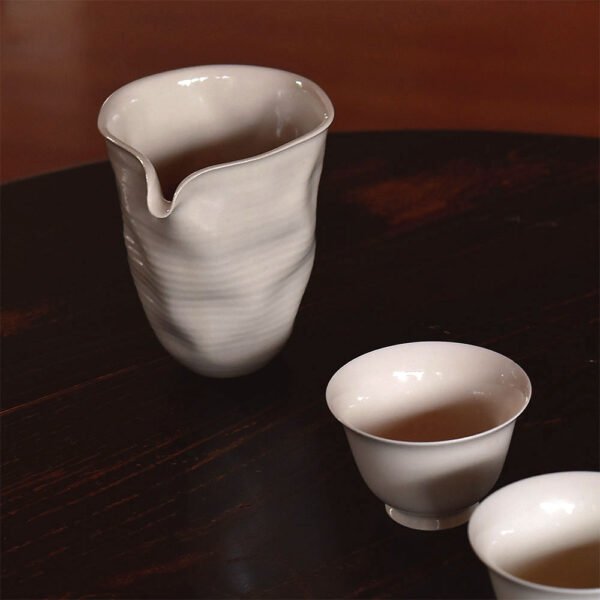 $119.99
$119.99This fair cup has been wood ash glazed which gives it an earthy and organic feature. This glaze is often made by collecting the ash from burnt wood and mixing it with clay, creating a natural and rustic finish.
The unique shape created by the hand-pinching process gives the fair cup an individual character and charm. Each piece would be slightly different, with its own organic curves, asymmetries, and irregularities. These variations would make it even more special and add to its natural beauty.
Its natural and earthy appearance would evoke a sense of calmness and harmony, making it the perfect vessel for enjoying a warm cup of tea.

 $489.99
$489.99This is a Blue-and-White Camellia Gaiwan, crafted entirely by hand using traditional blue-and-white porcelain techniques. The Gaiwan features camellia flowers as its primary design motif, with petals rendered in a refined and elegant style. The branches and leaves add a touch of natural vitality, exuding beauty and harmony. Since ancient times, camellias have symbolized resilience and purity, as well as passion and grace, embodying blessings of good fortune and happiness.
The overall design of the Gaiwan is well-proportioned, with a smooth and rounded rim that feels comfortable to hold. The lid knob is thoughtfully designed for easy handling, ensuring both functionality and aesthetic appeal. The deep blue of the floral motifs contrasts beautifully with the bright white porcelain base, creating a striking visual effect that highlights the unique texture of blue-and-white porcelain. The finely detailed camellia patterns showcase exceptional craftsmanship, demonstrating the high level of artistry involved in its creation.
Additionally, the Gaiwan adopts a Ming Dynasty-inspired design, with its most notable feature being the tin spots effect. These spots result from a high concentration of iron elements in specific areas of the blue pigment. During the firing process, as the kiln cools after reaching high temperatures, the oversaturated iron elements crystallize and precipitate, giving the tea ware its distinctive charm.
The blue-and-white porcelain technique, a classic art form in Chinese ceramics, is beloved for its simplicity and expressive beauty. On this Gaiwan, the camellia patterns appear as if they are blooming upon the porcelain, making it not only a practical tea vessel but also a piece of collectible art. Whether for daily tea brewing or as an elegant display, this Gaiwan reflects the owner’s refined taste and appreciation for cultural heritage.

 $499.99
$499.99This Gaiwan is meticulously handcrafted using the blue-and-white with underglaze red technique. The artwork features camellia flowers, symbolising passion and beauty, often used to convey auspiciousness and blessings for happiness.
Blue-and-White with Underglaze Red (commonly known as “blue-and-purple”) is a ceramic decorative method in which underglaze red designs are added to blue-and-white patterns. Blue-and-white refers to patterns drawn with cobalt oxide, covered with a transparent glaze, and fired at over 1200°C in a reduction atmosphere to produce the characteristic underglaze decoration. Underglaze red uses copper oxide as a colouring agent, painted directly on the clay body (or on clay coated with a transparent white glaze), then covered with a clear glaze. After being placed in a saggar and fired at 1250–1280°C in a strong reduction atmosphere, the high-valence copper is reduced to low-valence copper, creating vivid yet subdued red patterns.
In this technique, underglaze red can be used to decorate the spaces between blue-and-white patterns, resulting in the unique combination known as blue-and-white with underglaze red. This complex process creates a striking artistic effect where blue, red, and white colours complement each other.
The production of blue-and-white with underglaze red ceramics is extraordinarily challenging. Historically, some artisans risked financial ruin in their pursuit of this technique due to its complexity. The difficulty arises because the cobalt (blue) and copper (red) oxides require different reduction temperatures, making it exceptionally hard to control the process. This results in a low success rate, with issues such as “flying red,” where the red and blue merge or the colours become indistinct and blurry.
Despite these challenges, the combination of blue-and-white with underglaze red achieves an unparalleled artistic effect, where the interplay of blue, red, and white elevates the beauty of ceramics to new artistic heights. This Gaiwan exemplifies the mastery of this rare and sophisticated craft, making it a stunning and meaningful piece of art.
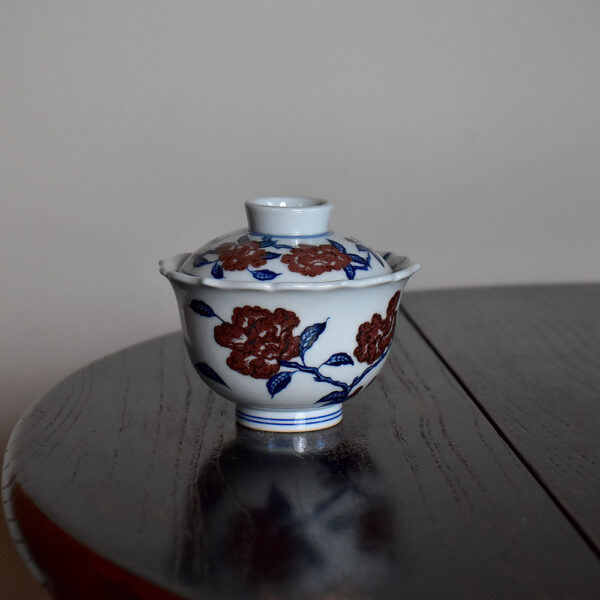
 $499.99
$499.99This Gaiwan is meticulously handcrafted using the blue-and-white with underglaze red technique. The artwork features camellia flowers, symbolising passion and beauty, often used to convey auspiciousness and blessings for happiness. Its distinctive floral rim design resembles blooming petals, seamlessly blending the warmth of the porcelain with the elegance of blooming flowers, adding a touch of vitality and charm to the Gaiwan.
Blue-and-White with Underglaze Red (commonly known as “blue-and-purple”) is a ceramic decorative method in which underglaze red designs are added to blue-and-white patterns. Blue-and-white refers to patterns drawn with cobalt oxide, covered with a transparent glaze, and fired at over 1200°C in a reduction atmosphere to produce the characteristic underglaze decoration. Underglaze red uses copper oxide as a colouring agent, painted directly on the clay body (or on clay coated with a transparent white glaze), then covered with a clear glaze. After being placed in a saggar and fired at 1250–1280°C in a strong reduction atmosphere, the high-valence copper is reduced to low-valence copper, creating vivid yet subdued red patterns.
In this technique, underglaze red can be used to decorate the spaces between blue-and-white patterns, resulting in the unique combination known as blue-and-white with underglaze red. This complex process creates a striking artistic effect where blue, red, and white colours complement each other.
The production of blue-and-white with underglaze red ceramics is extraordinarily challenging. Historically, some artisans risked financial ruin in their pursuit of this technique due to its complexity. The difficulty arises because the cobalt (blue) and copper (red) oxides require different reduction temperatures, making it exceptionally hard to control the process. This results in a low success rate, with issues such as “flying red,” where the red and blue merge or the colours become indistinct and blurry.
Despite these challenges, the combination of blue-and-white with underglaze red achieves an unparalleled artistic effect, where the interplay of blue, red, and white elevates the beauty of ceramics to new artistic heights. This Gaiwan exemplifies the mastery of this rare and sophisticated craft, making it a stunning and meaningful piece of art.

 $639.99
$639.99This tea tray, designed in the style of the Ming Dynasty, is crafted using the underglaze blue and white porcelain technique, and is entirely hand-painted. The intricate and exquisite artwork features peach blossoms, ducks, butterflies, and the spring river. Two adult ducks, accompanied by ducklings, swim freely in the warming spring waters, surrounded by blooming peach blossoms and playful butterflies. The scene is vivid and natural, evoking a serene beauty. The artwork captures the essence of early spring on the river, portraying how ducks are the first to sense the warming waters, expressing joy and reverence for the arrival of spring.
Design and Appearance
- Shape: The tea tray has smooth lines and a comfortable grip, combining unique and beautiful design elements.
- Glaze Color: The surface of the tea tray has a warm and smooth glaze. The base color is white, with the hand-painted underglaze blue technique, creating a deep and layered blue color.
Craftsmanship and Techniques
- Hand-Painted Artwork: The designs on the tea tray are meticulously hand-painted, making each piece unique and full of artistic value.
- Tin Spot Technique: The glaze surface uses the tin spot technique, creating a mottled visual effect that adds a sense of history and texture, enhancing the antique charm of the tea tray.
Ming-style teaware always features a distinctive tin spot pattern, giving the tea ware a unique charm. The formation of tin spots is due to the high content of iron elements in local parts of the blue pigment. After reaching saturation in the high-temperature glaze solution and cooling down, the iron elements in the supersaturated part start to precipitate. If the iron content of the blue pigment is higher and the cooling rate is appropriate, tin spots are more likely to appear on the surface of the ware.
In addition to firing and materials, the formation of tin spots also involves the factor of glaze material. During the painting process, tin spots can also be formed due to the accumulation of blue pigment. Tin spots are more likely to appear on the surface of the ware at the intersections and the starting and ending points of brushstrokes. The formation of tin spots can be said to be a natural creation or an artificial decoration. These tin glazes not only add a rustic texture to the tea tray but also imbue it with a unique sense of history.
The artwork on this tea tray is delicate, with fine brushstrokes that outline a unique sense of line beauty. The underglaze blue pigment is rich, featuring distinctive and prominent tin spots that appear exceptionally beautiful and captivating under the light.

 $749.99
$749.99This gaiwan, designed in the style of the Ming Dynasty, is crafted using the underglaze blue and white porcelain technique, and is entirely hand-painted. The intricate and exquisite artwork features peach blossoms, ducks, butterflies, and the spring river. Two adult ducks, accompanied by ducklings, swim freely in the warming spring waters, surrounded by blooming peach blossoms and playful butterflies. The scene is vivid and natural, evoking a serene beauty. The artwork captures the essence of early spring on the river, portraying how ducks are the first to sense the warming waters, expressing joy and reverence for the arrival of spring.
Design and Appearance
- Shape: The gaiwan has smooth lines and a comfortable grip, combining unique and beautiful design elements.
- Glaze Color: The surface of the gaiwan has a warm and smooth glaze. The base color is white, with the hand-painted underglaze blue technique, creating a deep and layered blue color.
Craftsmanship and Techniques
- Hand-Painted Artwork: The designs on the gaiwan are meticulously hand-painted, making each piece unique and full of artistic value.
- Tin Spot Technique: The glaze surface uses the tin spot technique, creating a mottled visual effect that adds a sense of history and texture, enhancing the antique charm of the gaiwan.
Ming-style teaware always features a distinctive tin spot pattern, giving the tea ware a unique charm. The formation of tin spots is due to the high content of iron elements in local parts of the blue pigment. After reaching saturation in the high-temperature glaze solution and cooling down, the iron elements in the supersaturated part start to precipitate. If the iron content of the blue pigment is higher and the cooling rate is appropriate, tin spots are more likely to appear on the surface of the ware.
In addition to firing and materials, the formation of tin spots also involves the factor of glaze material. During the painting process, tin spots can also be formed due to the accumulation of blue pigment. Tin spots are more likely to appear on the surface of the ware at the intersections and the starting and ending points of brushstrokes. The formation of tin spots can be said to be a natural creation or an artificial decoration. These tin glazes not only add a rustic texture to the Gaiwan but also imbue it with a unique sense of history.
The artwork on this gaiwan is delicate, with fine brushstrokes that outline a unique sense of line beauty. The underglaze blue pigment is rich, featuring distinctive and prominent tin spots that appear exceptionally beautiful and captivating under the light.

 $418.99
$418.99This Blue and White Landscape Gaiwan is handcrafted using traditional blue and white porcelain techniques, showcasing the elegant style of traditional Chinese landscape painting. The gaiwan features intricate landscape scenes, depicting bridges, mountains, rivers, trees, pavilions, and figures, creating a sense of tranquility and timelessness. The blue glaze varies in intensity, creating depth and dimension, capturing both the grandeur of the landscape and the finer details. The blue and white patterns on the tea set harmonize with the tea when poured, enhancing the tea-drinking experience.
Design and Appearance:
- Shape: The gaiwan has a classic shape with smooth lines, offering a comfortable grip and adhering to the traditional design of tea ware.
- Pattern: The hand-painted blue and white landscape pattern on the gaiwan is exquisitely detailed, showcasing the artist’s superior craftsmanship, especially in the depiction of rocks and trees, giving a three-dimensional effect.
Craftsmanship and Techniques:
- Blue and White Technique: This gaiwan is crafted using traditional blue and white porcelain techniques. The blue pigment fuses with the porcelain at high temperatures, resulting in a bright and stable glaze that is resistant to fading. The blue hue exudes a delicate tone under light, appearing particularly fresh and vibrant.
- Hand-Painted: The entire piece is hand-painted by skilled artisans, with each stroke infused with artistic expression, reflecting the artist’s profound understanding of traditional landscape aesthetics. Hand-painting ensures that each tea set is unique, with subtle differences that express the individuality and emotion of the artist. This handcrafted warmth and uniqueness cannot be matched by mass-produced items.
The Blue and White Landscape tea set is not just a functional utensil but also a symbol of traditional Chinese culture and art. It embodies the Chinese love for nature, the pursuit of art, and the appreciation of life aesthetics. Using such a tea set is not only about enjoying the flavor of the tea but also about savoring a cultural experience and lifestyle.
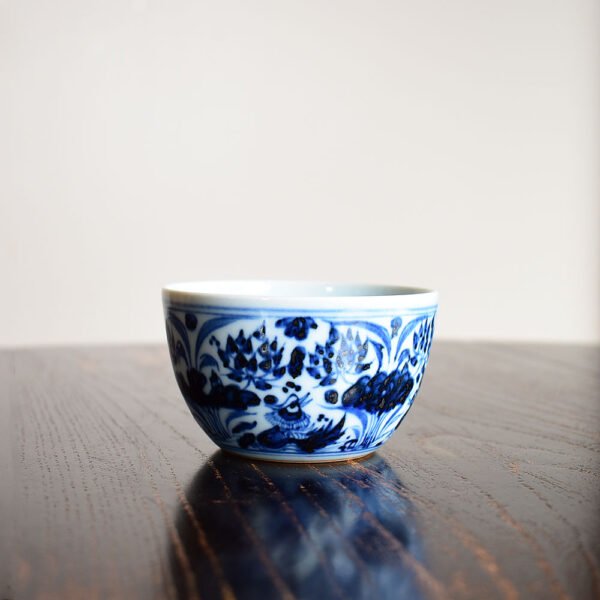
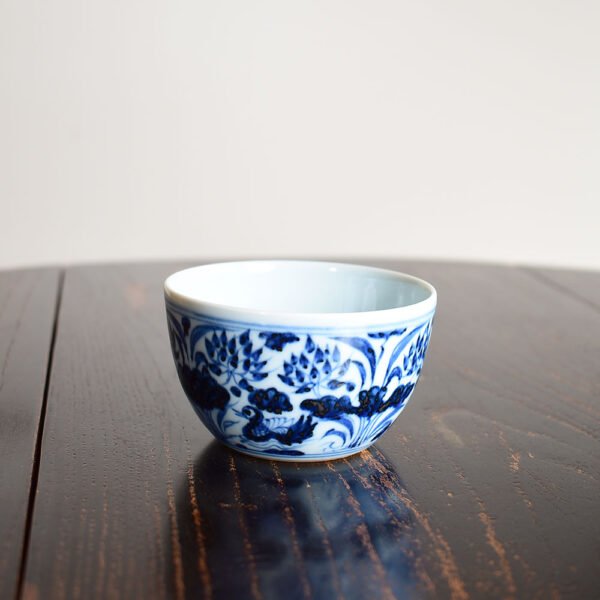 $439.99
$439.99This master teacup is made in the style of the Yuan dynasty blue and white porcelain, completely handmade and hand-painted. The entire painting exudes a strong sense of antiquity, with bold and vigorous lines, and the mandarin ducks playing in water pattern appear vivid and lifelike.
In traditional Chinese culture, the symbol of mandarin ducks playing in water holds profound significance. ‘Mandarin ducks’ refer to a loving couple, while ‘playing in water’ symbolizes the beautiful vision of shared life and mutual efforts. In ancient Chinese literature, the motif of mandarin ducks playing in water is widely used to portray the affection between spouses and the blissful and harmonious life they lead. Moreover, it embodies a harmonious, balanced, and optimistic attitude towards life.
There are various representations of mandarin ducks playing in the water, with the most common being the image of two mandarin ducks frolicking in the water, portraying a scene of affection and harmony. In this depiction, mandarin ducks are often gracefully rendered, displaying light postures, splendid feathers, and vibrant colours. Additionally, scenes of mandarin ducks playing in the water are often accompanied by depictions of lotus leaves, lotus flowers, and other plants, creating a refreshing and enchanting ambiance.
Besides, for Yuan blue and white porcelain refers to the blue and white porcelain produced during the Yuan dynasty (1271-1368) in China. The Yuan dynasty was an important period in the history of Chinese porcelain and one of the peaks of Chinese porcelain art. As one of the representatives of that era, Yuan blue and white porcelain exhibited unique artistic styles and technical levels. The characteristic of Yuan blue and white is the use of cobalt blue pigment for painting, which is made of cobalt oxide. After firing, the colour is bright and rich, with an extremely high decorative effect. Yuan blue and white porcelain has various shapes, thick and heavy, concise, and fluent lines, and stable and solemn shapes, all made exquisitely.
The evolution of Yuan blue and white is based on the foundation of Tang and Song celadon. Firstly, the glaze colour was improved and innovated. Unique white glaze, eggshell glaze and blue-white glaze were invented to make the glaze crystal clear. Cobalt pigment was imported for glaze colouring. Or using the pigment made from domestic materials.
The formation of tin spots on Yuan blue and white is due to the high content of iron elements in local parts of the blue pigment. After reaching saturation in the high-temperature glaze solution and cooling down, the iron elements in the supersaturated part start to precipitate. If the iron content of the blue pigment is higher and the cooling rate is appropriate, tin spots are more likely to appear on the surface of the ware.
In addition to firing and materials, the formation of tin spots also involves the factor of glaze material. During the painting process, tin spots can also be formed due to the accumulation of blue pigment. Tin spots are more likely to appear on the surface of the ware at the intersections and the starting and ending points of brushstrokes. The formation of tin spots can be said to be a natural creation or an artificial decoration.
This master teacup has a smooth and lustrous texture and uses the Su Ma Li Qing glaze material (a kind of blue pigment), with a heavy sense of tin spots, revealing a unique charm of the past era. The entire production process is completed by hand, and every detail has been carefully designed and polished, giving this teacup a unique artistic charm. The blue and white mandarin ducks playing in water pattern is vivid, showcasing ancient cultural and aesthetic values, allowing people to immerse themselves in a beautiful artistic atmosphere while enjoying their tea.
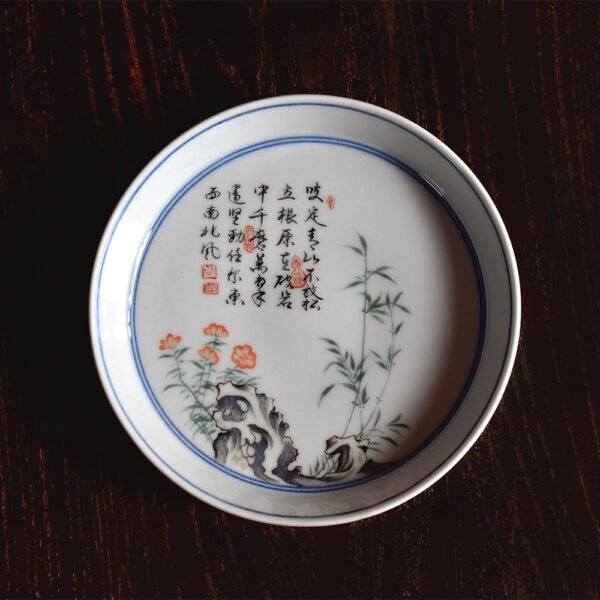
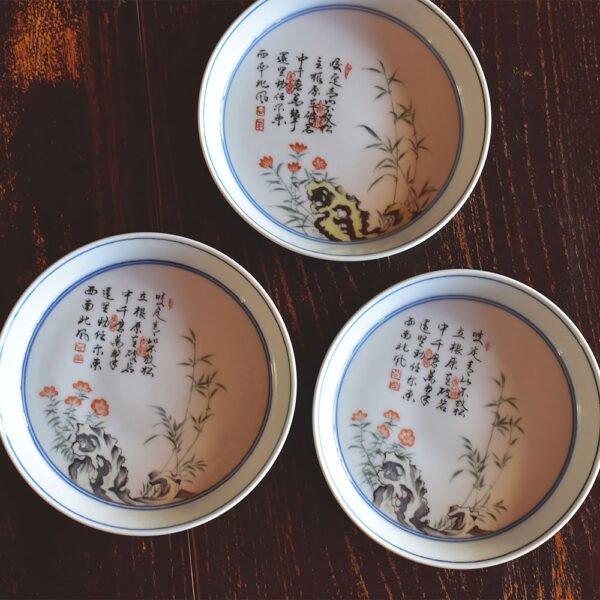 $99.99
$99.99This tea tray is made with antique clay glaze, which gives it a smooth and lustrous surface, as well as a thick and sturdy body, evoking a sense of ancient elegance, tranquillity, and warmth. The hand-painted strokes are lively and natural, depicting the bamboo forest and rocks with lifelike accuracy.
The Chinese bamboo forest and rocks have profound symbolic meanings in culture and art. The bamboo forest symbolizes resilience and humility. Bamboo is known for its strong vitality and flexible nature, able to withstand harsh winters and remain upright. This characteristic has made bamboo a symbol of traditional virtues in China, including perseverance, resilience in adversity, and modesty. Additionally, the bamboo forest is often seen as a place of seclusion, representing the pursuit of inner freedom and tranquillity. Rocks, on the other hand, symbolize stability and steadfastness. In Chinese art, rocks are frequently depicted as rugged, majestic, and serene. They represent the eternal and unchanging aspects of the natural world, as well as the values of determination and stability that people strive for in life. Rocks are also seen as symbols of wisdom and longevity, standing tall and unwavering despite the passage of time.
Furthermore, the tea tray is crafted using the overglaze colour painting craft, which produces pure, vibrant, and full colours. Since tea tray is hand-painted by an artist, every piece is unique and machine-printed decals cannot compare with.
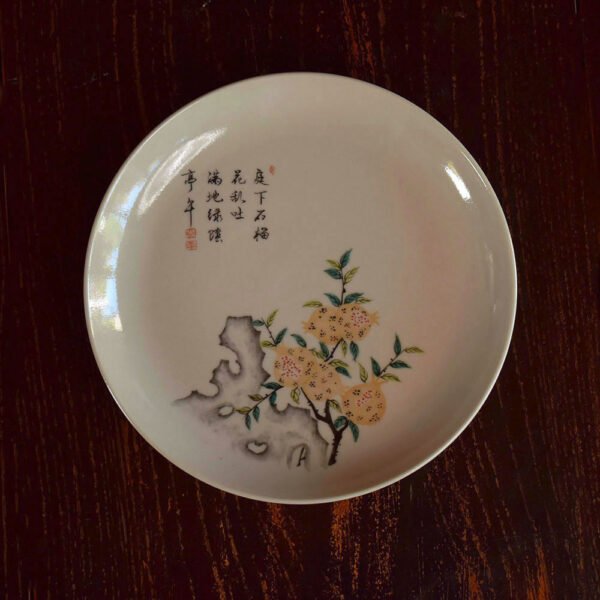
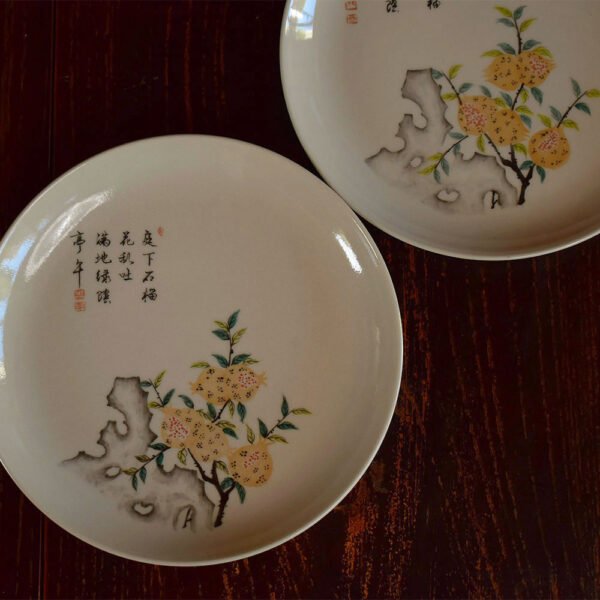 $99.99
$99.99This tea tray is made with wood ash glaze, with a smooth and glossy glaze surface and a thick and solid body, giving it a sense of antique elegance, tranquillity, and warmth. The hand-painted picture is vivid and natural, depicting lifelike pomegranates.
In ancient China, pomegranates symbolized a prosperous and auspicious life with abundance, good fortune, and prosperity. The pomegranate is red both inside and outside, symbolizing a vibrant life and passionate individuals. As the pomegranate has numerous seeds, people use it as a symbol of wishing for a large and prosperous family, and the ancients referred to it as ‘a thousand chambers with the same membrane, a thousand children as one’.
This tea tray is made using the overglaze technique, with vibrant and full colours in the painted design. Each lid bowl is individually hand-painted by skilled artists, making each one unique and machine-printed decals cannot compare with.
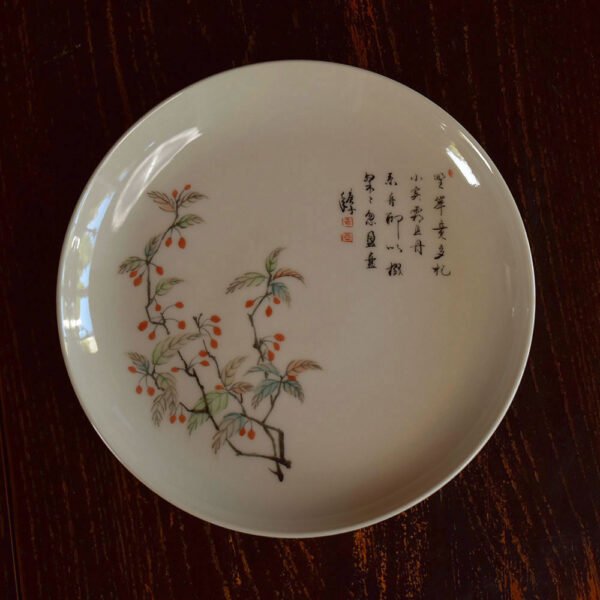
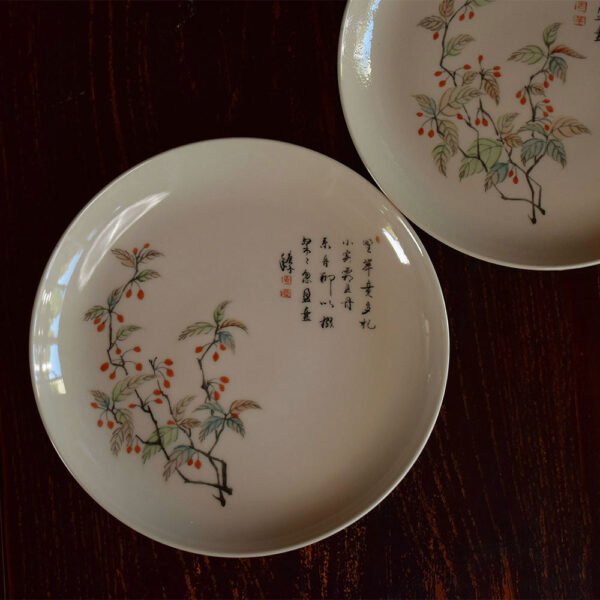 $99.99
$99.99This tea tray is made with wood ash glaze, with a smooth and glossy glaze surface and a thick and solid body, giving it a sense of antique elegance, tranquillity, and warmth. The hand-painted picture is vivid and natural, depicting lifelike Goji.
Goji berries, a small orange-red fruit with a long history in China, symbolize auspiciousness and happiness. The elongated fruits of goji berries are fiery red in colour, hence in China, goji berries are regarded as a symbol of celebration and joy. The fiery red goji berries represent good luck and signify a life filled with prosperity and vitality.
Furthermore, the tea tray is crafted using the overglaze colour painting craft, which produces pure, vibrant, and full colours. Since the tea tray is hand-painted by an artist, every piece is unique, and machine-printed decals cannot be compared with.
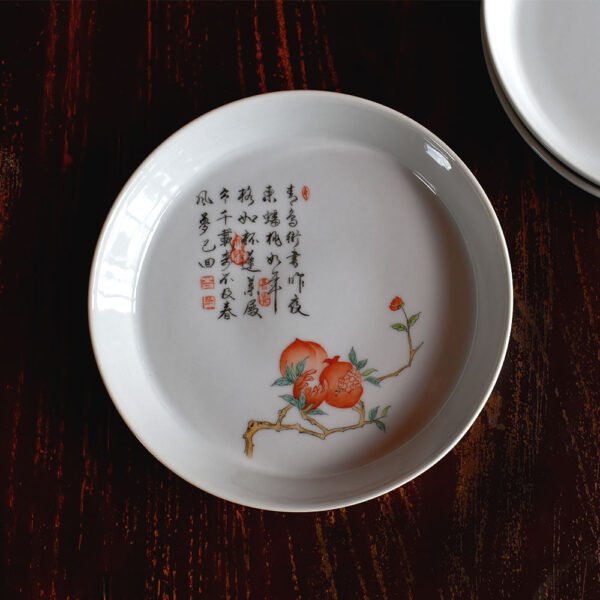
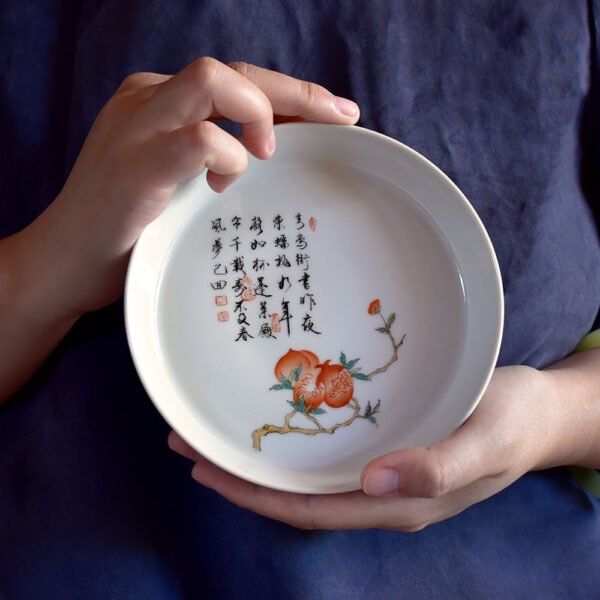 $99.99
$99.99This tea tray is made with imitation antique clay glaze, with a smooth and glossy glaze surface and a thick and solid body, giving it a sense of antique elegance, tranquillity, and warmth. The hand-painted picture is vivid and natural, depicting lifelike pomegranates.
‘San Duo’ is a traditional auspicious pattern in China, originating from the phrase “Hua Feng San Zhu Duo Fu, Duo Shou, Duo Zi,” which means “abundant blessings, longevity, and many children.” Traditional patterns often consist of Buddha’s hand citron, peaches, and pomegranates. This pattern features pomegranates. In ancient China, pomegranates symbolized a prosperous and auspicious life with abundance, good fortune, and prosperity. The pomegranate is red both inside and outside, symbolizing a vibrant life and passionate individuals. As the pomegranate has numerous seeds, people use it as a symbol of wishing for a large and prosperous family, and the ancients referred to it as ‘a thousand chambers with the same membrane, a thousand children as one’.
This tea tray is made using the overglaze technique, with vibrant and full colours in the painted design. Each lid bowl is individually hand-painted by skilled artists, making each one unique and machine-printed decals cannot compare with.
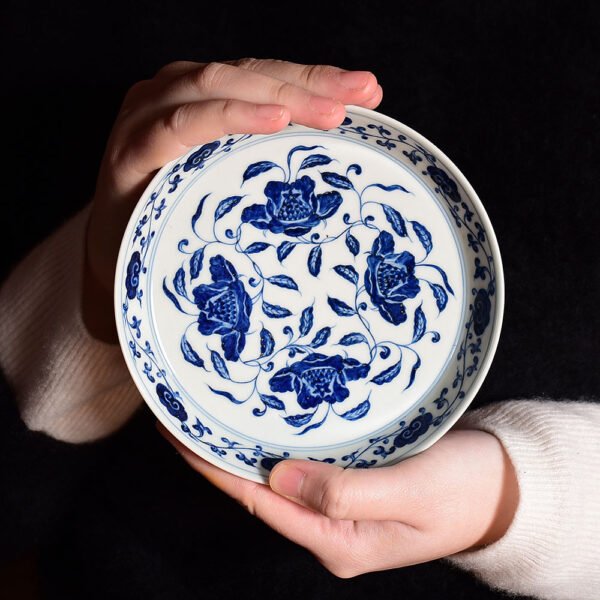
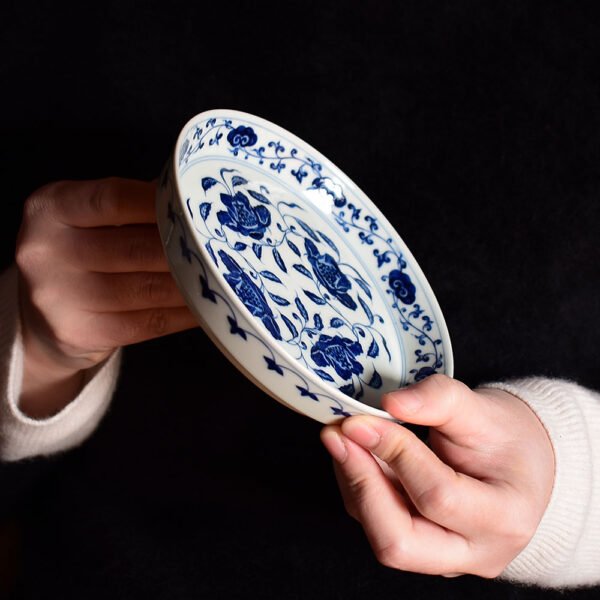 $519.99
$519.99This tea tray is crafted with antique-style clay and meticulously made using underglaze blue techniques. Its delicate brushwork, subtle tin speckles, and warm, solid texture unique to antique-style clay imbue this tea tray with an aura of classical elegance and exquisite beauty.
The decorative pattern on this tea tray features camellia flowers, adorned with Ruyi motifs on the sides. In ancient China, camellia flowers held rich symbolism and meaning. Firstly, camellia flowers symbolize resilience. As one of the few flowers that bloom in winter, camellias demonstrate remarkable endurance and can bloom independently even in the harsh cold. Therefore, camellias represent tenacity and the need for unwavering perseverance to achieve success. Secondly, camellias also symbolize love. With their vibrant colours and blossoms resembling smiling lips, camellias are not only beautiful but also convey passion. They are often used to express love, symbolizing the warmth and beauty of romantic affection. Lastly, camellias signify purity. Their simple coloration, free from the complexity and flamboyance of other flowers, makes them a symbol of purity and freshness, representing a pure and innocent heart.
The Ruyi motifs on the sides of this tea tray also carry auspicious meanings. The Ruyi symbolizes auspiciousness and good fortune. Its rounded and flawless form embodies blessings, satisfaction, and wishes fulfilled. Underneath its graceful appearance, it holds profound significance, representing the auspicious and delightful ideals of good fortune and contentment.
Expect those two traditional patterns, the beautiful tin speckles on the porcelain further enhance its unique charm. The formation of tin spots on Yuan blue and white is due to the high content of iron elements in local parts of the blue pigment. After reaching saturation in the high-temperature glaze solution and cooling down, the iron elements in the supersaturated part start to precipitate. If the iron content of the blue pigment is higher and the cooling rate is appropriate, tin spots are more likely to appear on the surface of the ware.
In addition to firing and materials, the formation of tin spots also involves the factor of glaze material. During the painting process, tin spots can also be formed due to the accumulation of blue pigment. Tin spots are more likely to appear on the surface of the ware at the intersections and the starting and ending points of brushstrokes. The formation of tin spots can be said to be a natural creation or an artificial decoration.
The body of this tea tray has a smooth and lustrous texture, with underglaze blue patterns that appear vivid and lifelike. The subtle tin speckles add a touch of nostalgia and natural beauty, exuding an old-world charm. Every brushstroke of the underglaze blue design is enchanting and vibrant. This beautiful blue-and-white tea tray not only embellishes your tea setting but also embodies the continuation of ancient culture and the expression of aesthetics. It allows you to immerse yourself in a graceful artistic atmosphere while enjoying your tea.
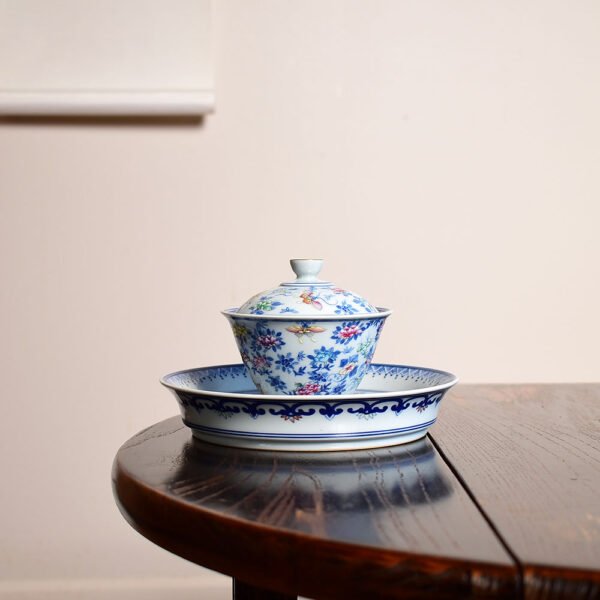
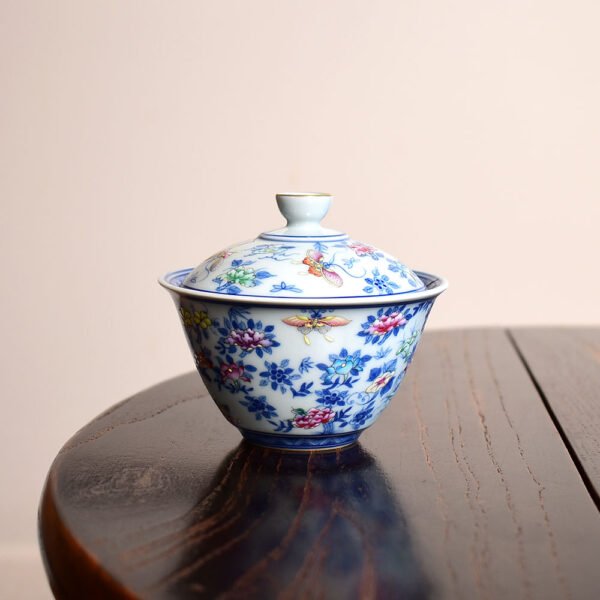 From: $2,168.98
From: $2,168.98This tea set is handcrafted using the technique of Blue-and-white underglaze colour and enamel glazed painting. The design features a pattern of butterflies amid flowers, displaying rich and lifelike colours, creating a unique and charming ambiance.
Blue and White Enamel is a distinctive porcelain decoration technique that combines the traditional methods of blue and white with enamel. It is a variation of the traditional Chinese porcelain production, blending the characteristics of blue and white with enamel, resulting in a captivating and unique decorative style.
Blue and White refers to the technique of painting blue patterns on the porcelain surface. It originated during the Yuan dynasty but reached its peak during the Ming and Qing dynasties. This decorative method uses cobalt oxide blue pigments that fuse with the porcelain surface at high temperatures, ensuring the patterns’ durability.
Enamel, on the other hand, is a decorative technique that involves transplanting the cloisonné enamel method onto a porcelain body as an overglaze colour decoration. Enamel decoration on porcelain, known as “Fàlángcǎi” in Chinese, entails painting colourful patterns on the porcelain surface and then firing it at high temperatures to fuse the colours with the porcelain, achieving a durable and splendid design. These patterns often feature exquisite themes such as flowers, birds, figures, and landscapes, reflecting the essence of traditional Chinese culture and art.
The process of creating enamel decorations is extremely intricate and complex, requiring skilled and experienced craftsmen. First, the porcelain prototype is made, and then special mineral pigments are used to paint patterns on its surface. Once the painting is completed, a series of firing processes follow, during which the temperature and timing for both the porcelain and the enamel colours are crucial factors. Improper temperature or timing can result in cracks in the porcelain or unstable colours. Enamel decoration is considered a treasure in traditional Chinese craftsmanship, representing the wisdom and skills of ancient Chinese artisans.
The combination of blue and white enamel unites these two techniques, typically starting with the blue and white technique to depict blue patterns, and then applying enamel decoration to add additional colours and enhance the visual effect and three-dimensional sense of the design. This decorative method enriches the patterns on the porcelain while preserving the distinctive features of both blue and white and enamel techniques. During the Ming and Qing dynasties, blue and white enamel reached its peak and became one of the main styles for porcelain decoration at that time.
The design on this tea set showcases lifelike patterns of butterflies amid flowers. “Butterflies in Love with Flowers” symbolises sweet love and blissful marriage. In recent times, people have endowed this motif with more profound meanings, expressing good wishes and symbolizing beautiful and prosperous love. Butterflies are often seen as symbols of happiness and love, inspiring and captivating people’s imagination, and aspirations. In traditional Chinese literature, a pair of flying butterflies represents the pursuit of free and passionate love. Butterflies are loyal to their mates, having only one partner throughout their lives, making them a symbol of fidelity in the insect world. Moreover, there is a beautiful Chinese folktale known as “The Butterfly Lovers,” which further enhances the symbolism of sweet love and harmonious marriage associated with the motif of butterflies and flowers.
This enamel-decorated tea set displays a rich and colourful palette, with lively and dynamic brushstrokes, immersing people in an elegant artistic ambiance while enjoying their tea.
This tea set includes:
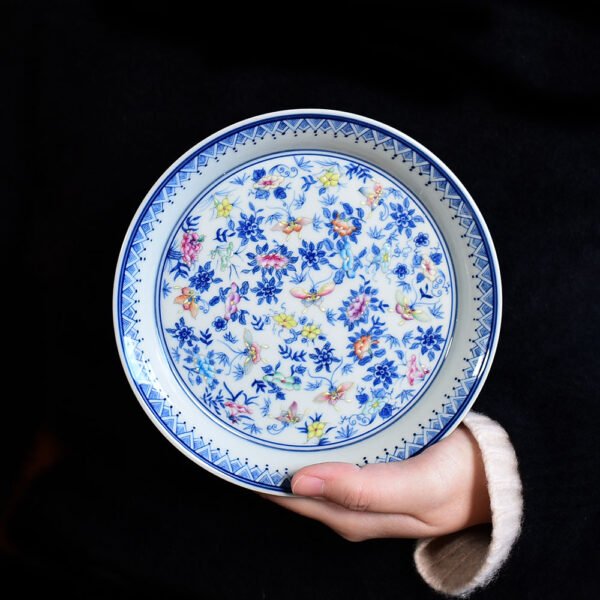
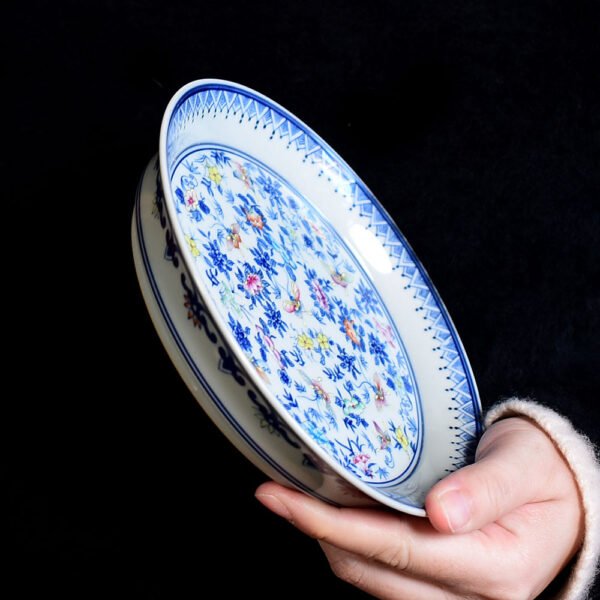 $1,168.99
$1,168.99This tea tray is handcrafted using the technique of Blue-and-white underglaze colour and enamel glazed paint. The design features a pattern of butterflies amid flowers, displaying rich and lifelike colours, creating a unique and charming ambiance.
Blue and White Enamel is a distinctive porcelain decoration technique that combines the traditional methods of blue and white with enamel. It is a variation of the traditional Chinese porcelain production, blending the characteristics of blue and white with enamel, resulting in a captivating and unique decorative style.
Blue and White refers to the technique of painting blue patterns on the porcelain surface. It originated during the Yuan dynasty but reached its peak during the Ming and Qing dynasties. This decorative method uses cobalt oxide blue pigments that fuse with the porcelain surface at high temperatures, ensuring the patterns’ durability.
Enamel, on the other hand, is a decorative technique that involves transplanting the cloisonné enamel method onto a porcelain body as an overglaze colour decoration. Enamel decoration on porcelain, known as “Fàlángcǎi” in Chinese, entails painting colourful patterns on the porcelain surface and then firing it at high temperatures to fuse the colours with the porcelain, achieving a durable and splendid design. These patterns often feature exquisite themes such as flowers, birds, figures, and landscapes, reflecting the essence of traditional Chinese culture and art.
The process of creating enamel decorations is extremely intricate and complex, requiring skilled and experienced craftsmen. First, the porcelain prototype is made, and then special mineral pigments are used to paint patterns on its surface. Once the painting is completed, a series of firing processes follow, during which the temperature and timing for both the porcelain and the enamel colours are crucial factors. Improper temperature or timing can result in cracks in the porcelain or unstable colours. Enamel decoration is considered a treasure in traditional Chinese craftsmanship, representing the wisdom and skills of ancient Chinese artisans.
The combination of blue and white enamel unites these two techniques, typically starting with the blue and white technique to depict blue patterns, and then applying enamel decoration to add additional colours and enhance the visual effect and three-dimensional sense of the design. This decorative method enriches the patterns on the porcelain while preserving the distinctive features of both blue and white and enamel techniques. During the Ming and Qing dynasties, blue and white enamel reached its peak and became one of the main styles for porcelain decoration at that time.
The design on this tea tray showcases lifelike patterns of butterflies amid flowers. “Butterflies in Love with Flowers” symbolises sweet love and blissful marriage. In recent times, people have endowed this motif with more profound meanings, expressing good wishes and symbolizing beautiful and prosperous love. Butterflies are often seen as symbols of happiness and love, inspiring and captivating people’s imagination, and aspirations. In traditional Chinese literature, a pair of flying butterflies represents the pursuit of free and passionate love. Butterflies are loyal to their mates, having only one partner throughout their lives, making them a symbol of fidelity in the insect world. Moreover, there is a beautiful Chinese folktale known as “The Butterfly Lovers,” which further enhances the symbolism of sweet love and harmonious marriage associated with the motif of butterflies and flowers.
This enamel-decorated tea tray displays a rich and colourful palette, with lively and dynamic brushstrokes, immersing people in an elegant artistic ambiance while enjoying their tea.
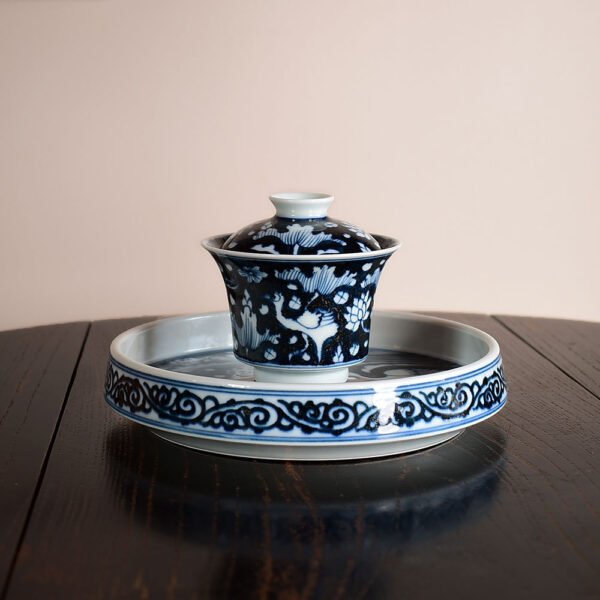
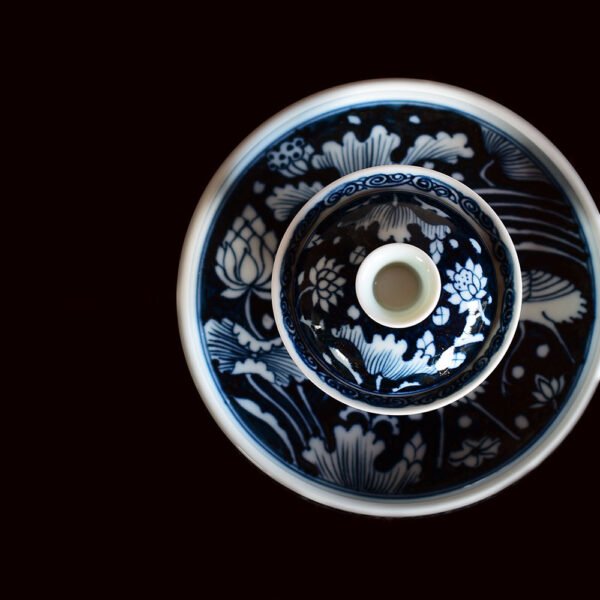 From: $559.98
From: $559.98This tea set is made in the style of the Yuan dynasty blue and white porcelain, completely handmade and hand-painted. The pattern of “一鹭莲科” or “一路连科” in Chinese culture is derived from the beautiful combination of the heron and lotus leaves. As “鹭” (heron) and “路” (path/road) have the same pronunciation, and “莲” (lotus) sounds like “连” (successive/continuous), the name “一路连科” is a play on words that conveys the beautiful meaning of the pattern. In ancient times, successive successful candidates in the imperial examinations were called “连科,” and “一路连科” is a good wish for students to have a smooth career path and achieve success step by step.
For Yuan blue and white porcelain refers to the blue and white porcelain produced during the Yuan dynasty (1271-1368) in China. The Yuan dynasty was an important period in the history of Chinese porcelain and one of the peaks of Chinese porcelain art. As one of the representatives of that era, Yuan blue and white porcelain exhibited unique artistic styles and technical levels. The characteristic of Yuan blue and white is the use of cobalt blue pigment for painting, which is made of cobalt oxide. After firing, the colour is bright and rich, with an extremely high decorative effect. Yuan blue and white porcelain has various shapes, thick and heavy, concise, and fluent lines, and stable and solemn shapes, all made exquisitely.
The evolution of Yuan blue and white is based on the foundation of Tang and Song celadon. Firstly, the glaze colour was improved and innovated. Unique white glaze, eggshell glaze and blue-white glaze were invented to make the glaze crystal clear. Cobalt pigment was imported for glaze colouring. Or using the pigment made from domestic materials.
The formation of tin spots on Yuan blue and white is due to the high content of iron elements in local parts of the blue pigment. After reaching saturation in the high-temperature glaze solution and cooling down, the iron elements in the supersaturated part start to precipitate. If the iron content of the blue pigment is higher and the cooling rate is appropriate, tin spots are more likely to appear on the surface of the ware.
In addition to firing and materials, the formation of tin spots also involves the factor of glaze material. During the painting process, tin spots can also be formed due to the accumulation of blue pigment. Tin spots are more likely to appear on the surface of the ware at the intersections and the starting and ending points of brushstrokes. The formation of tin spots can be said to be a natural creation or an artificial decoration.
This tea set has a thick body and uses the Su Ma Li Qing glaze material (a kind of blue pigment), with a heavy sense of tin spots, revealing a unique charm of the past era. The entire production process is completed by hand, and every detail has been carefully designed and polished, giving this tea set a unique artistic charm.
This tea set includes:
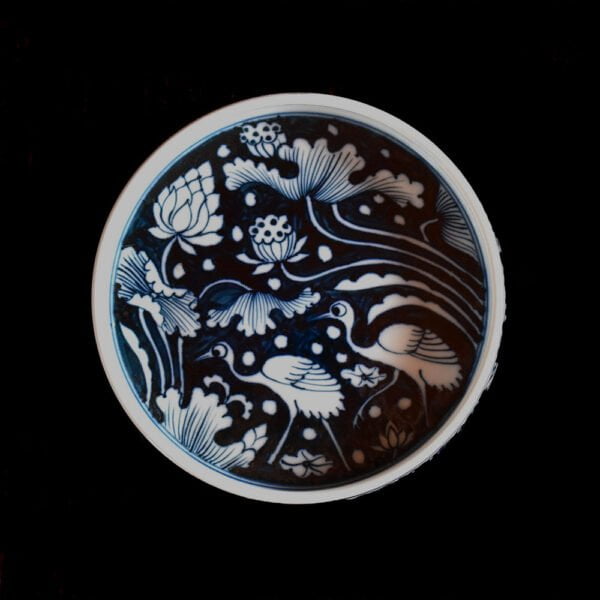
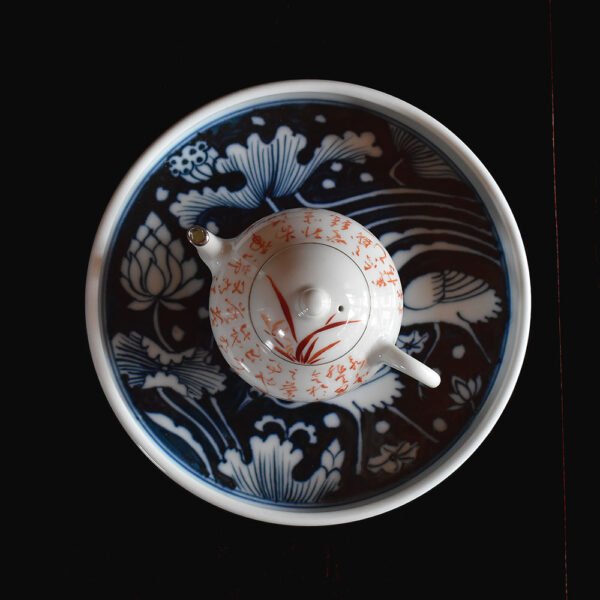 $279.99
$279.99This tea tray is made in the style of the Yuan dynasty blue and white porcelain, completely handmade and hand-painted. The pattern of “一鹭莲科” or “一路连科” in Chinese culture is derived from the beautiful combination of the heron and lotus leaves. As “鹭” (heron) and “路” (path/road) have the same pronunciation, and “莲” (lotus) sounds like “连” (successive/continuous), the name “一路连科” is a play on words that conveys the beautiful meaning of the pattern. In ancient times, successive successful candidates in the imperial examinations were called “连科,” and “一路连科” is a good wish for students to have a smooth career path and achieve success step by step.
For Yuan blue and white porcelain refers to the blue and white porcelain produced during the Yuan dynasty (1271-1368) in China. The Yuan dynasty was an important period in the history of Chinese porcelain and one of the peaks of Chinese porcelain art. As one of the representatives of that era, Yuan blue and white porcelain exhibited unique artistic styles and technical levels. The characteristic of Yuan blue and white is the use of cobalt blue pigment for painting, which is made of cobalt oxide. After firing, the colour is bright and rich, with an extremely high decorative effect. Yuan blue and white porcelain has various shapes, thick and heavy, concise, and fluent lines, and stable and solemn shapes, all made exquisitely.
The evolution of Yuan blue and white is based on the foundation of Tang and Song celadon. Firstly, the glaze colour was improved and innovated. Unique white glaze, eggshell glaze and blue-white glaze were invented to make the glaze crystal clear. Cobalt pigment was imported for glaze colouring. Or using the pigment made from domestic materials.
The formation of tin spots on Yuan blue and white is due to the high content of iron elements in local parts of the blue pigment. After reaching saturation in the high-temperature glaze solution and cooling down, the iron elements in the supersaturated part start to precipitate. If the iron content of the blue pigment is higher and the cooling rate is appropriate, tin spots are more likely to appear on the surface of the ware.
In addition to firing and materials, the formation of tin spots also involves the factor of glaze material. During the painting process, tin spots can also be formed due to the accumulation of blue pigment. Tin spots are more likely to appear on the surface of the ware at the intersections and the starting and ending points of brushstrokes. The formation of tin spots can be said to be a natural creation or an artificial decoration.
This tea tray has a thick body and uses the Su Ma Li Qing glaze material (a kind of blue pigment), with a heavy sense of tin spots, revealing a unique charm of the past era. The entire production process is completed by hand, and every detail has been carefully designed and polished, giving this tea tray a unique artistic charm.
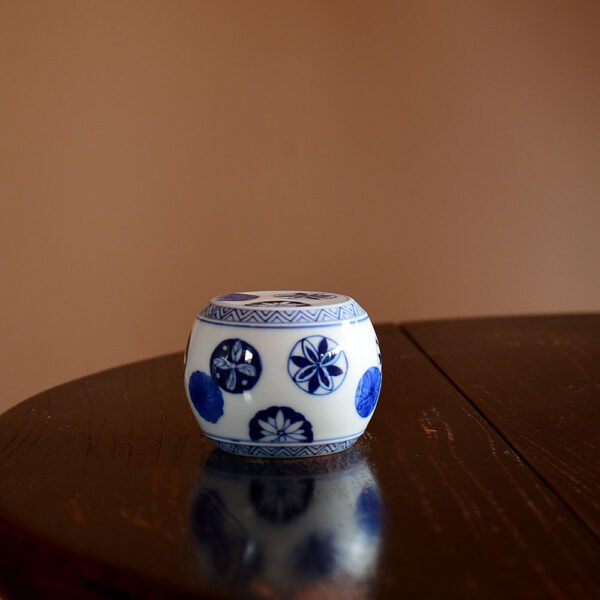
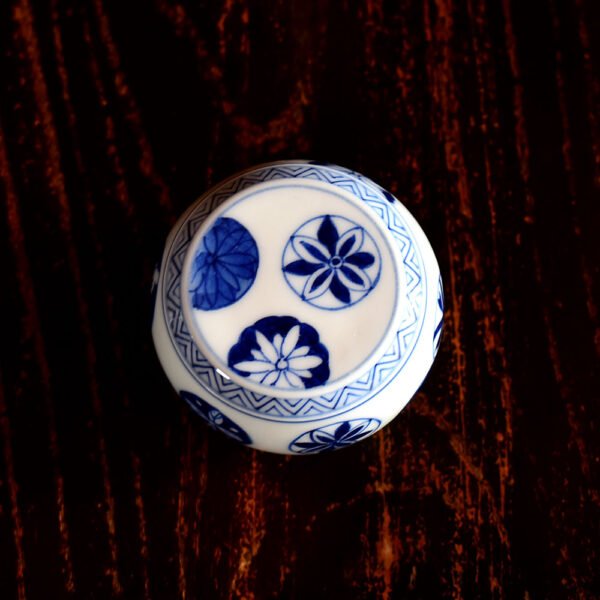 $75.99
$75.99This cover is fully hand-painted using the blue and white underglaze technology. It is an essential item for many people when brewing tea. It is used to hold teapot lids, Gaiwan lids, and cup lids. It not only keeps the lids of the teaware clean but also prevents them from wetting the tabletop.
The decorative pattern of Pi Qiu Hua (皮球花), also known as little tuan hua (小团花) or embroidery ball flower, evolved from the traditional tuan hua pattern on porcelain. This pattern has been present since the Sui Dynasty, and it combines abstract and representational elements. It takes various forms, resembling a spherical shape, hence the name Pi Qiu Hua (皮球花).
The decorative patterns on Chinese porcelain always carry auspicious meanings. Since the Pi Qiu Hua pattern originated from tuan hua, it inherits the traditional tuan hua motifs such as tuan long (团龙), tuan feng (团凤), and tuan hua (团花). These traditional motifs symbolize the abundance and beauty of life.
In this lid saucer, the delicate brushstrokes vividly outline the pattern, creating a glossy and elegant appearance. The colours are rich and vibrant, giving the piece a sense of vivid and liveliness.
Note: All are fully handmade, every lid saucer could be slightly different.
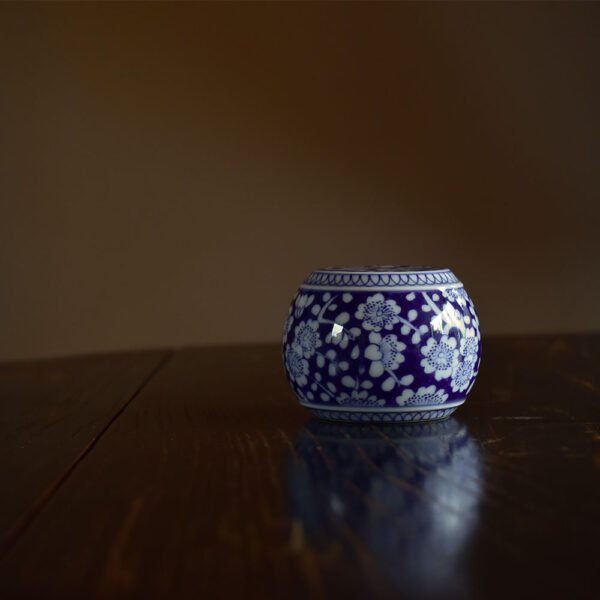
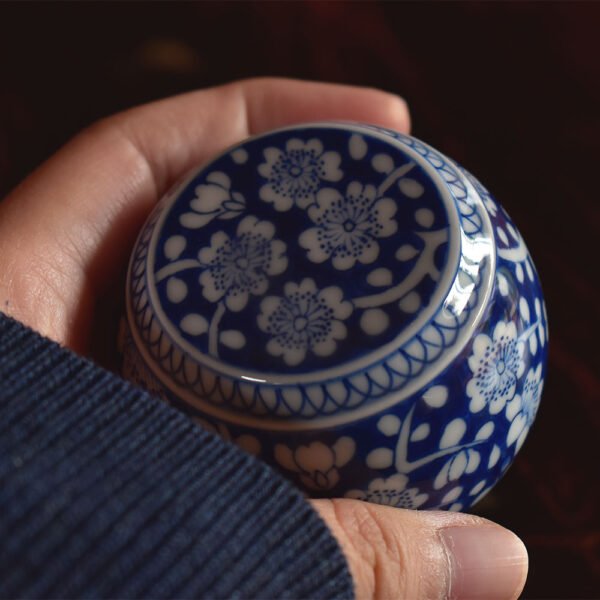 $75.99
$75.99This cover is fully hand-painted using the blue and white underglaze technology. It is an essential item for many people when brewing tea. It is used to hold teapot lids, Gaiwan lids, and cup lids. It not only keeps the lids of the tea ware clean but also prevents them from wetting the tabletop.
In ancient Chinese culture, the sunflower is regarded as a symbol of auspiciousness and happiness due to its radiating appearance and vibrant, bright colors. It represents a future filled with vitality, brightness, and hope.
In this lid saucer, the delicate brushstrokes vividly outline the flowers, creating a glossy and elegant appearance. The colours are rich and vibrant, giving the piece a sense of vivid and liveliness.
Note: All are fully handmade, every lid saucer could be slightly different.
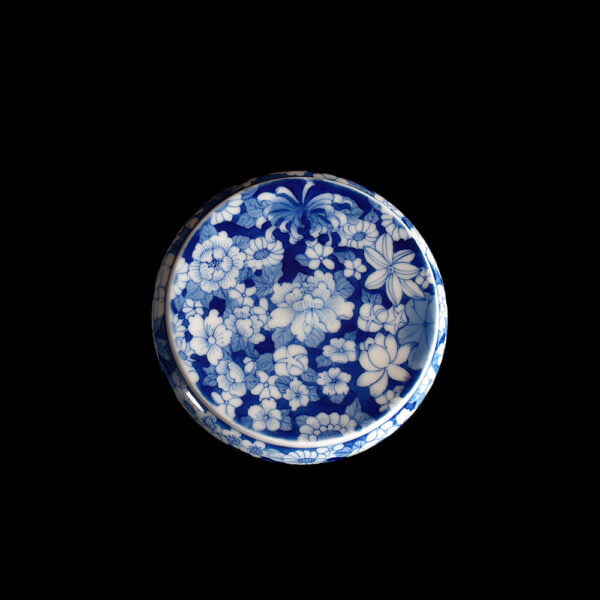
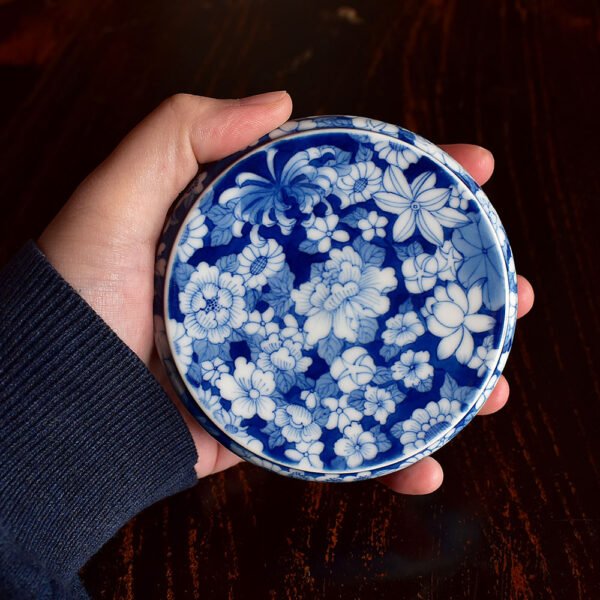 $229.99
$229.99This cover is fully hand-painted using the blue and white underglaze technology. It is an essential item for many people when brewing tea. It is used to hold teapot lids, Gaiwan lids, and cup lids. It not only keeps the lids of the teaware clean but also prevents them from wetting the tabletop.
The Wan-Hua design, also known as “myriad flowers,” “flowers on top of flowers,” or “adding flowers to enhance beauty,” is commonly depicted in the central area of the object. It often features large patterns of peonies, surrounded by various smaller floral patterns such as chrysanthemums, camellia, roses, lotuses, lilies, morning glories, and others. The intricate secondary patterns cover the entire surface, symbolizing the gathering of myriad flowers and representing prosperity and harmony.
In this lid saucer, the delicate brushstrokes vividly outline the different flowers, creating a glossy and elegant appearance. The colours are rich and vibrant, giving the piece a sense of vivid and liveliness.
Note: All are fully handmade, and every lid saucer can be slightly different.
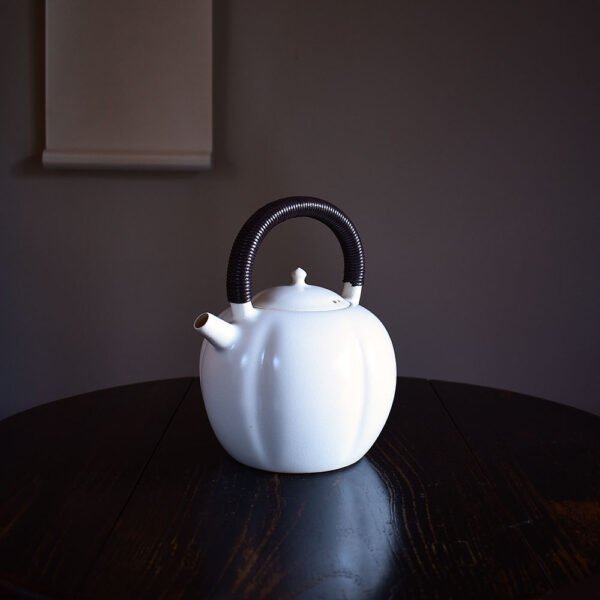
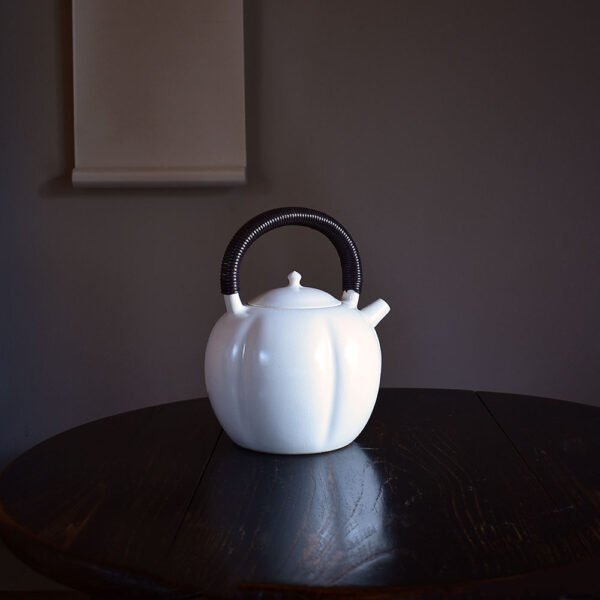 $279.99
$279.99This large teapot is crafted from high-quality raw clay and fired at high temperatures. The raw clay is extracted from natural deposits in mines, possessing the inherent qualities and advantages of the natural mineral, resulting in a more stable and pure texture. The body of this large teapot is glazed, seamlessly blending with the mottled and rustic texture of the clay, creating a smooth and natural appearance. The handle is hand-wrapped with woolen thread, providing insulation from heat. The steam hole on the edge of the teapot lid prevents the build-up of steam caused by boiling water. The tiny pores on the surface of the teapot are natural features left behind after firing with the original mineral glaze, showcasing the characteristics of the raw mineral glaze. The unique cracked glaze technique creates beautiful patterns on the surface as the cracks are formed by the long-term infusion of tea. Generally, the patterns created through the cracked glaze technique are unique, adding more enjoyment to the tea brewing process.
Besides that, soda glaze is another main character of this teapot. The soda glaze is crafted using imported raw minerals from Japan, where, through high-temperature firing, weak alkaline metal ions such as potassium, sodium, and calcium are released and incorporated into the glaze. The surface of the teapot bears tiny pores left behind by the firing process of the natural raw minerals. These breathable pores possess the unique ability to adsorb tea impurities, reduce bitterness, and maintain a refreshing, non-stuffy character, greatly enhancing the quality of the tea infusion. The result is a smoother, more delicate, and pleasantly aromatic tea experience. Upon heating with boiling water, the trace elements like boron, zinc, and lithium, found within the soda glaze, significantly soften the water quality. This effect causes the water molecules to exhibit a weak alkaline state, a characteristic not typically found in ordinary boiling vessels. This outstanding property has earned it the industry nickname – ‘the balance of regulating the body’s acid-alkaline equilibrium.’ Prolonged use of the soda-glazed miniature teapot proves highly beneficial for one’s health.
It’s important to note that during the initial stages of boiling water, the teapot may experience sweating, which is a normal occurrence. Simply proceed with the usual process of boiling the water. After brewing tea, the surface of the teapot will develop delicate patterns resembling cicada wings and golden threads. Prolonged use will further enhance these patterns, resulting in a charming antique appearance that becomes more intriguing over time.
Maintenance Guidelines:
Initial Use: For a new teapot, it’s important to boil water in it before regular use. Fill the teapot to about one-sixth of its capacity with clean water, bring it to a boil, and then pour out the water. Next, fill the teapot with clean water and add a small amount of rice. Boil the water with the rice for approximately one hour (be cautious not to burn the rice). After discarding the rice and water, there’s no need to clean the teapot. Let it sit overnight, then wash it the next day. Boil clean water in the teapot twice before using it for tea.
Important Points:
Avoid Dry Heating: Never heat the teapot without water, as it can cause the teapot to crack. Also, avoid rapid temperature changes. Refilling: If you need to refill the teapot, ensure there’s residual water inside. Test the bottom of the teapot with your hand to make sure it’s not too hot before adding more water. It’s recommended to fill the water up to the level where it reaches the first water outlet hole.
Suggestions:
This teapot is made from natural raw clay, which has good breathability. After each tea session, make sure to pour out any remaining water from the teapot to prevent water droplets from forming at the bottom the next day.
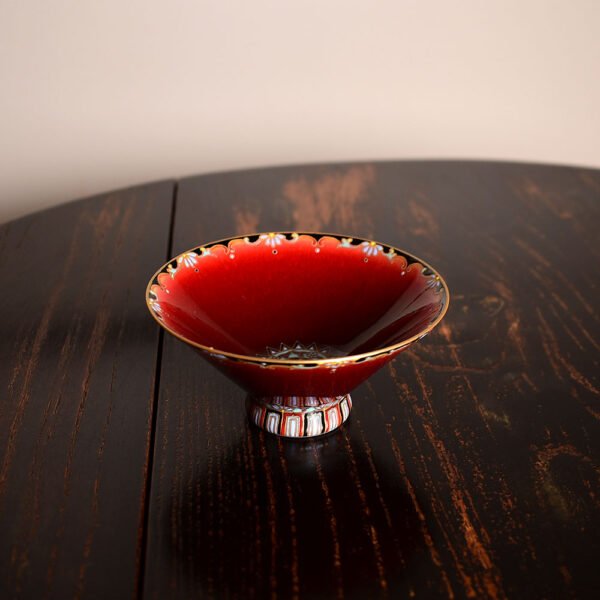
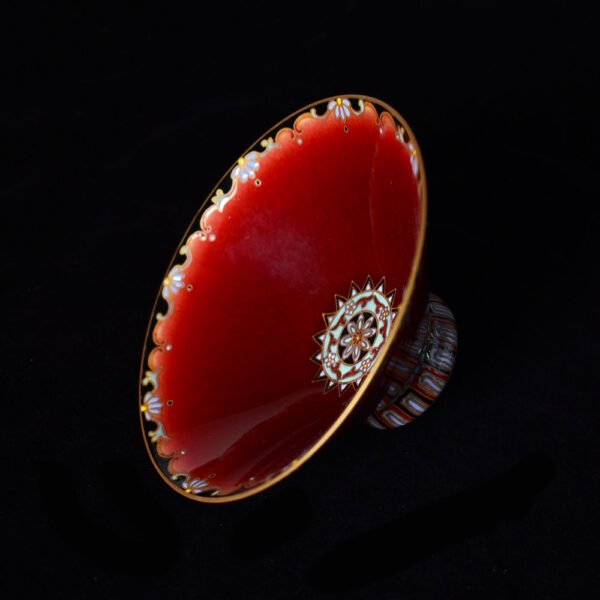 $489.99
$489.99This hat cup is handcrafted using the technique of gold painting, Lang Hong colouring and enamel glazed paint. The pattern on its painting is Dunhuang-style, with vibrant and luxurious colours, exuding a sense of luxury and elegance.
Gold painting, one of the decorative techniques, involves applying gold powder (gold dust) or bright gold (gold solution) on the porcelain surface to create intricate patterns or to complement other decorations as borders or a golden background. Afterwards, the cup is fired at a low temperature to achieve the final finish. The rim of this teacup’s mouth employs the gold painting technique.
The patterns on this cup depict Dunhuang-style designs, layered and intricate, displaying a rich array of colours. Among them, the lotus pattern is the most used decorative motif in Dunhuang art. From the Northern Liang to the Yuan Dynasty, lotus flowers can be found in every cave of the Mogao Grottoes. In Buddhism, the lotus symbolizes purity and enlightenment. It is believed that one’s soul can attain rebirth through the lotus, leading to the blissful Western Pure Land. Within the Mogao Grottoes, lotus flowers adorn the background, embellishing figures of bodhisattvas and celestial beings, embodying the sacred and immaculate nature of Buddhas and bodhisattvas. Hence, the lotus is the quintessential flower representing Buddhism. Apart from the lotus, another significant motif is the honeysuckle, also known as Jin Hua (golden-silver flower). It is an important decorative symbol in Dunhuang art, introduced alongside Buddhist art in China as a decorative floral theme. The rise of honeysuckle patterns in China occurred nearly simultaneously with the spread of Buddhism. Its extensive use in Buddhist decorations during the Northern Dynasties influenced secular ornamentation at that time. Honeysuckle blooms during summer, transitioning from white to yellow after budding, shedding old leaves in late autumn, and promptly producing new leaves. It endures even in the harshest winter conditions, quietly thriving in the wild with minimal requirements of water and soil. As a result, the honeysuckle pattern found abundant application in Buddhist-related decorations, drawing from its persistent growth characteristics. Furthermore, the motif of the “Baoxiang Flower,” also known as Baoxianhua or Baolianhua, is another traditional auspicious pattern in Dunhuang decorations. It is one of the auspicious Three Treasures and was prevalent during China’s Sui and Tang Dynasties. The concept of “Baoxiang” originates from Buddhism, where it refers to a respectful term for Buddhist images. The Baoxiang Flower represents an idealized form of purity, grace, and beauty.
In addition to these captivating decorative patterns, the craftsmanship of Lang Hong ceramics is also deserving of praise. Firstly, the full name of Lang Hong is “Langyao Red,” also known as “Gem Red” or “Ox Blood Red.” It is one of the most vibrant colours in traditional Chinese precious copper red glazes. Lang Hong glaze is achieved by using copper as a colouring agent and firing it at a high temperature of 1300°C. Since copper elements easily evaporate at high temperatures, the range of colour expression is limited. The firing process demands strict control over the atmosphere and temperature, and the outcome is greatly affected by external factors, making it a highly challenging process to successfully produce Lang Hong ceramics. Lang Hong glaze boasts a smooth and translucent surface, resembling glass, with crackled patterns resembling cow hair texture. The glaze exhibits a deep and vivid colour, resembling freshly congealed ox blood with its brilliant crimson hue, symbolizing auspiciousness, and wealth. Revered as a “treasure among a thousand kilns,” the red-glazed porcelain of Lang Hong showcases a distinctive ethnic style, shining like a dazzling gem in the history of world ceramics. The colour red, known for its auspiciousness and affluence, has elevated Lang Hong ceramics to a radiant and remarkable masterpiece in the realm of ceramic art.
Enamel, on the other hand, is a decorative technique that involves transplanting the cloisonné enamel method onto a porcelain body as an overglaze colour decoration. Enamel decoration on porcelain, known as “Fàlángcǎi” in Chinese, entails painting colourful patterns on the porcelain surface and then firing it at high temperatures to fuse the colours with the porcelain, achieving a durable and splendid design. These patterns often feature exquisite themes such as flowers, birds, figures, and landscapes, reflecting the essence of traditional Chinese culture and art. The process of creating enamel decorations is extremely intricate and complex, requiring skilled and experienced craftsmen. First, the porcelain prototype is made, and then special mineral pigments are used to paint patterns on its surface. Once the painting is completed, a series of firing processes follow, during which the temperature and timing for both the porcelain and the enamel colours are crucial factors. Improper temperature or timing can result in cracks in the porcelain or unstable colours. Enamel decoration is considered a treasure in traditional Chinese craftsmanship, representing the wisdom and skills of ancient Chinese artisans.
This hat cup showcases exquisite Lang Hong craftsmanship, with intricate and delicate Dunhuang patterns that carry profound symbolism.
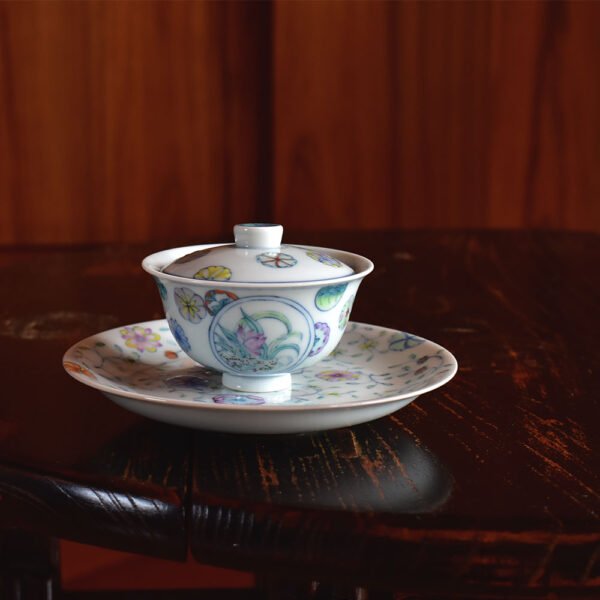
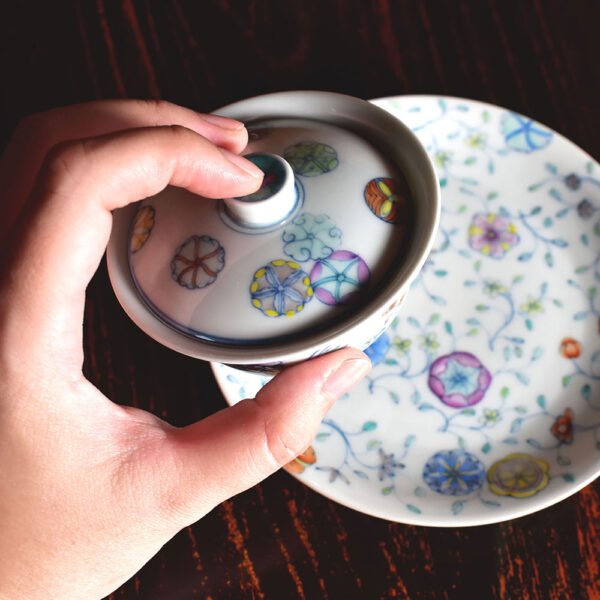 From: $619.98
From: $619.98This small and delicate Dou Cai Pi Qiu Hua teaware set is meticulously crafted with the technique of clashing colour.
As we all know, Doucai is a precious art form in traditional Chinese porcelain craftsmanship. It originated and was fired during the Xuande period of the Ming Dynasty, and Dou Cai from the Chenghua period of the Ming Dynasty is highly esteemed. Dou Cai is a type of decoration that combines underglaze blue (qinghua) and overglaze colour painting.
Dou Cai involves applying mineral pigments onto the previously fired underglaze blue porcelain, filling in the gaps left by the underglaze blue patterns and colouring the space within the outline of the underglaze blue design. The porcelain is then fired in a lower-temperature kiln (800°C). Dou Cai is renowned for its vibrant and varied colour palette, as well as its refined and sophisticated decorative style that reflects the aesthetic taste of the Ming Dynasty.
The decorative pattern of Pi Qiu Hua (皮球花), also known as little tuan hua (小团花) or embroidery ball flower, evolved from the traditional tuan hua pattern on porcelain. This pattern has been present since the Sui Dynasty, and it combines abstract and representational elements. It takes various forms, resembling a spherical shape, hence the name Pi Qiu Hua (皮球花).
The decorative patterns on Chinese porcelain always carry auspicious meanings. Since the Pi Qiu Hua pattern originated from tuan hua, it inherits the traditional tuan hua motifs such as tuan long (团龙), tuan feng (团凤), and tuan hua (团花). These traditional motifs symbolize the abundance and beauty of life.
This beautiful tea set, with its vibrant colours and exquisite craftsmanship, is an eye-catching presence wherever it is placed. Imagine having a cup of spring tea by using this charming tea set, it could be the most delightful experience for a day!
This tea set includes:
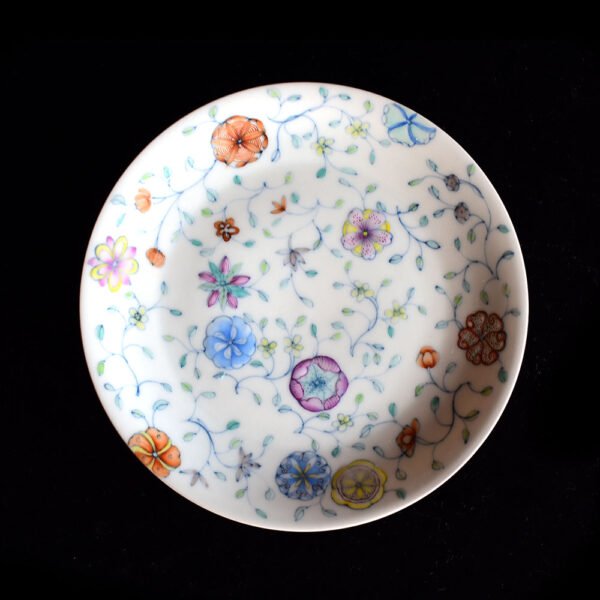
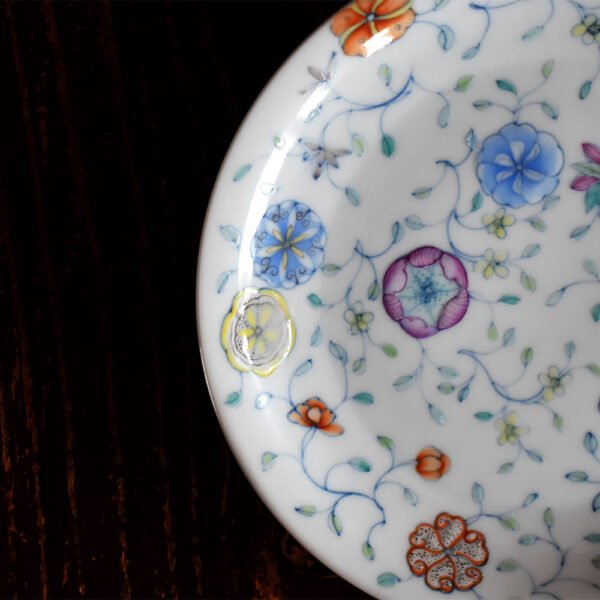 $279.99
$279.99This small and delicate Dou Cai Pi Qiu Hua tea tray is meticulously crafted with the technique of clashing colour.
As we all know, Doucai is a precious art form in traditional Chinese porcelain craftsmanship. It originated and was fired during the Xuande period of the Ming Dynasty, and Dou Cai from the Chenghua period of the Ming Dynasty is highly esteemed. Dou Cai is a type of decoration that combines underglaze blue (qinghua) and overglaze colour painting.
Dou Cai involves applying mineral pigments onto the previously fired underglaze blue porcelain, filling in the gaps left by the underglaze blue patterns and colouring the space within the outline of the underglaze blue design. The porcelain is then fired in a lower-temperature kiln (800°C). Dou Cai is renowned for its vibrant and varied colour palette, as well as its refined and sophisticated decorative style that reflects the aesthetic taste of the Ming Dynasty.
The decorative pattern of Pi Qiu Hua (皮球花), also known as little tuan hua (小团花) or embroidery ball flower, evolved from the traditional tuan hua pattern on porcelain. This pattern has been present since the Sui Dynasty, and it combines abstract and representational elements. It takes various forms, resembling a spherical shape, hence the name Pi Qiu Hua (皮球花).
The decorative patterns on Chinese porcelain always carry auspicious meanings. Since the Pi Qiu Hua pattern originated from tuan hua, it inherits the traditional tuan hua motifs such as tuan long (团龙), tuan feng (团凤), and tuan hua (团花). These traditional motifs symbolize the abundance and beauty of life.
This beautiful tea tray, with its vibrant colours and exquisite craftsmanship, is an eye-catching presence wherever it is placed. Imagine having a cup of spring tea by using this charming tea tray, it could be the most delightful experience for a day!
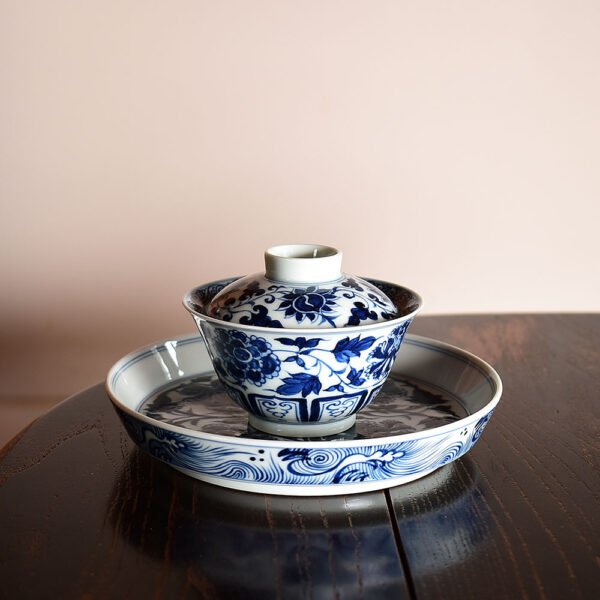
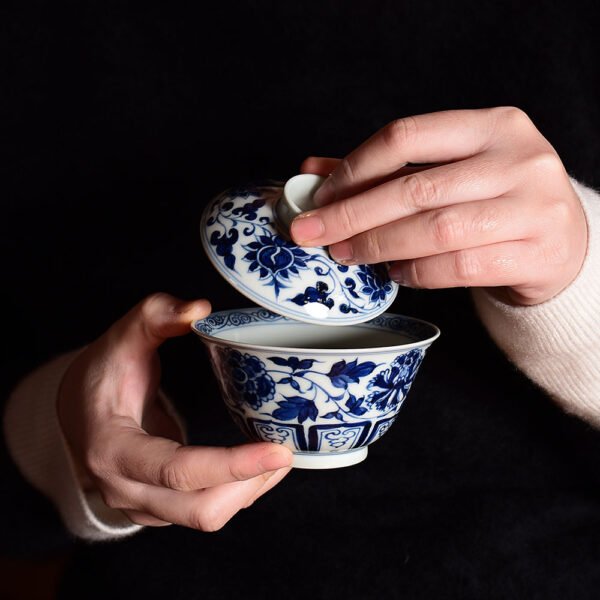 From: $989.98
From: $989.98The style of this super beautiful Gaiwan is Ming, using the underglaze blue technique, and entirely handcrafted and hand painted. The pattern features the classic design of intertwining Peony branches.
Peony, one of the beloved traditional patterns in our country, holds a special place in the hearts of the Chinese people with its lush and vibrant appearance and striking colors. As a symbol of our national spirit, it embodies the beautiful aspirations and good wishes for life, symbolizing the prosperity and longevity of the Chinese nation, with a history that stretches far into the past. The intertwined peony, known as “Wanshou Teng” or “Peony with Entwined Branches,” is a traditional auspicious pattern, that represents joyous occasions. Its continuous interlocking structure also conveys the meaning of “endless vitality” or “continuous growth.”
In addition, the beautiful tin spots on the porcelain add even more unique charm to it. The formation of tin spots is due to the high content of iron elements in local parts of the blue pigment. After reaching saturation in the high-temperature glaze solution and cooling down, the iron elements in the supersaturated part start to precipitate. If the iron content of the blue pigment is higher and the cooling rate is appropriate, tin spots are more likely to appear on the surface of the ware.
In addition to firing and materials, the formation of tin spots also involves the factor of glaze material. During the painting process, tin spots can also be formed due to the accumulation of blue pigment. Tin spots are more likely to appear on the surface of the ware at the intersections and the starting and ending points of brushstrokes. The formation of tin spots can be said to be a natural creation or an artificial decoration. This tin glazes not only add a rustic texture to the Gaiwan but also imbue it with a unique sense of history.
This Gaiwan exudes a charming style reminiscent of imitating the essence of Yuan Dynasty tea sets.
This tea set includes:

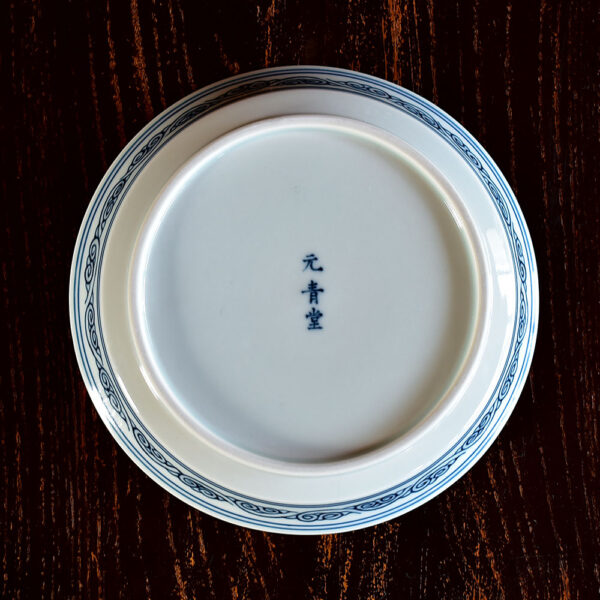 $279.99
$279.99In Chinese culture, the dragon is a very important symbol and totem with rich symbolism. Firstly, the dragon is one of the most sacred, authoritative, and noble images in ancient Chinese culture. It is the incarnation of the gods of heaven, earth, and water, representing supreme authority and divine power. Secondly, the dragon is considered a symbol of good luck in Chinese culture. As it has the special power to control rainfall, it is also seen as the protector of agriculture, representing a bountiful harvest and prosperity. Additionally, the dragon has many other symbolic meanings, such as longevity, authority, success, courage, and wisdom. In traditional Chinese culture, the dragon is a noble, mysterious, and awe-inspiring image, representing people’s yearning for the unknown and the spirit of exploration.
This tea tray is made in the style of the Yuan dynasty blue and white porcelain, completely handmade and hand painted. The blue and white dragon pattern is vivid, showcasing ancient cultural and aesthetic values, allowing people to immerse themselves in a beautiful artistic atmosphere while enjoying their tea.
For Yuan blue and white porcelain refers to the blue and white porcelain produced during the Yuan dynasty (1271-1368) in China. The Yuan dynasty was an important period in the history of Chinese porcelain and one of the peaks of Chinese porcelain art. As one of the representatives of that era, Yuan blue and white porcelain exhibited unique artistic styles and technical levels. The characteristic of Yuan blue and white is the use of cobalt blue pigment for painting, which is made of cobalt oxide. After firing, the colour is bright and rich, with extremely high decorative effect. Yuan blue and white porcelain has various shapes, thick and heavy, concise, and fluent lines, and stable and solemn shapes, all made exquisitely.
The evolution of Yuan blue and white is based on the foundation of Tang and Song celadon. Firstly, the glaze colour was improved and innovated. Unique white glaze, eggshell glaze and blue-white glaze were invented to make the glaze crystal clear. Cobalt pigment was imported for glaze colouring. Or using the pigment made from domestic materials.
The formation of tin spots on Yuan blue and white is due to the high content of iron elements in local parts of the blue pigment. After reaching saturation in the high-temperature glaze solution and cooling down, the iron elements in the supersaturated part start to precipitate. If the iron content of the blue pigment is higher and the cooling rate is appropriate, tin spots are more likely to appear on the surface of the ware.
In addition to firing and materials, the formation of tin spots also involves the factor of glaze material. During the painting process, tin spots can also be formed due to the accumulation of blue pigment. Tin spots are more likely to appear on the surface of the ware at the intersections and the starting and ending points of brushstrokes. The formation of tin spots can be said to be a natural creation or an artificial decoration.
This tea tray has a thick body and uses the Su Ma Li Qing glaze material (a kind of blue pigment), with a heavy sense of tin spots, revealing a unique charm of the past era. The entire production process is completed by hand, and every detail has been carefully designed and polished, giving this tea tray a unique artistic charm. The blue and white dragon pattern is vivid, showcasing ancient cultural and aesthetic values, allowing people to immerse themselves in a beautiful artistic atmosphere while enjoying their tea.
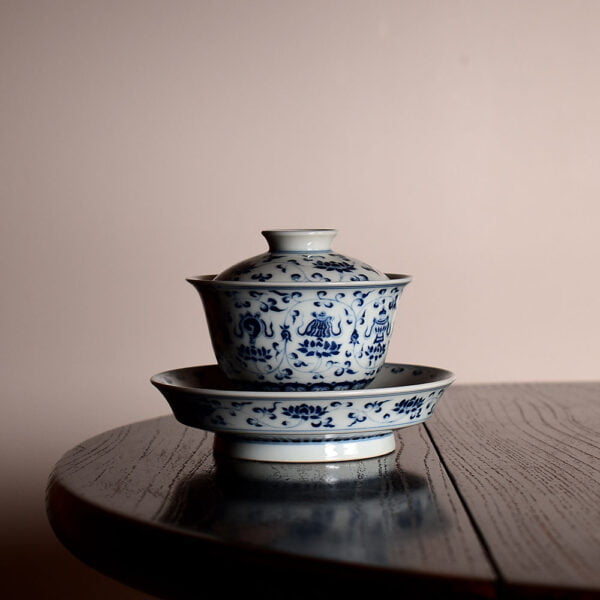
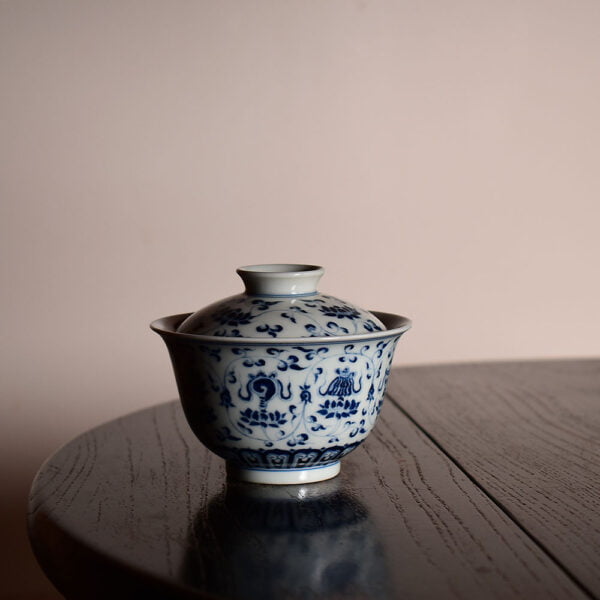 From: $1,695.98
From: $1,695.98The style of this super beautiful tea set is Ming, using the underglaze blue technique, and entirely handcrafted and hand painted. The pattern features very traditional Chinese patterns including intertwining lotus and ‘Ba Bao’.
The “Ba Bao,” also known as the “Buddhist Eight Treasures” or “Eight Auspicious Treasures,” represent eight auspicious objects symbolizing the power of Buddhism. These symbols manifest through the perception of eight types of consciousness: eyes, ears, nose, tongue, body, mind, intellect, and consciousness. They are depicted in various patterns and motifs as decorations in Buddhist art.
During the Qing Dynasty, particularly during the reign of Emperor Qianlong, these eight auspicious symbols were transformed into three-dimensional display items. They were often placed together with ritual vessels in temples. The eight auspicious symbols are abbreviated as follows: Conch Shell, Dharma Wheel, Umbrella, Canopy, Lotus Flower, Vase, Fish, and Endless Knot.
According to Buddhist beliefs, each of the “Eight Auspicious Symbols” has specific symbolic meanings:
- Conch Shell: Represents the auspicious sound of the Dharma, spreading throughout the world as a symbol of good fortune.
- Dharma Wheel: Signifies the endless cycle of Buddhist teachings, symbolizing the continuity of life.
- Umbrella: Symbolizes protection and the ability to shield and safeguard all sentient beings.
- Canopy: Represents the protection of the world and purification of the universe, symbolizing liberation from poverty and illness.
- Lotus Flower: Symbolizes purity and divine birth, representing the rejection of contamination.
- Vase: Represents the perfection of wisdom and fulfillment, symbolizing the achievement of success.
- Fish: Symbolizes liveliness, health, and vitality, serving as a sign of good luck and warding off evil spirits.
- Endless Knot: Represents the interconnectedness and endless nature of all things, symbolizing longevity, and a hundred years of life.
The construction of these symbols focuses on using auspicious objects as the main decorative elements, with their forms often being symmetrical or balanced. Some are complemented by flowing ribbons, while others are placed on a lotus pedestal, creating a harmonious and coherent effect among the different auspicious treasures.
During the Tang and Song Dynasties, the Eight Auspicious Symbols were introduced to the central plains with the spread of Tibetan Buddhism. By the Yuan Dynasty, they began to appear on silk, ceramics, gold, and silver items. In the Ming and Qing Dynasties, the application of the Eight Auspicious Symbols became even more widespread, involving lacquerware, furniture, architectural decorations, and other areas of craftsmanship.
The delicate brushstrokes and intricate detailing of the painting on this tea set create a distinct sense of aesthetic appeal. The soft and elegant shade of underglaze blue, along with a hint of faint tin glaze, gives it a graceful and ethereal beauty under the light. This tea set exudes a simple yet elegant charm, reminiscent of the style of imitation Ming, making it truly captivating and irresistible.
This tea set includes:
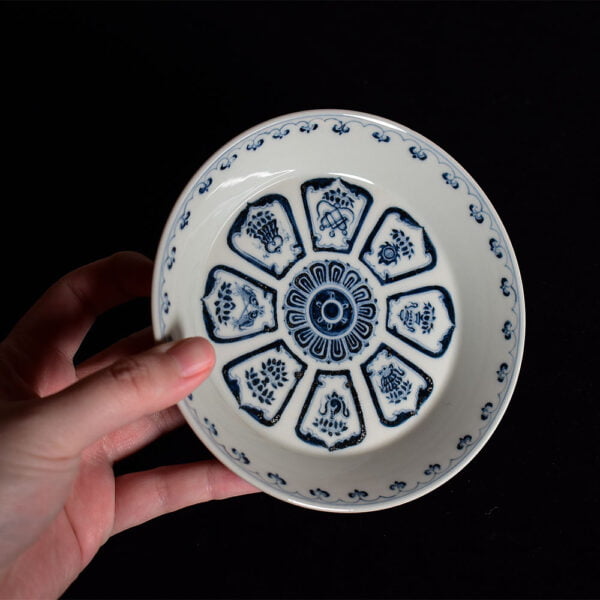
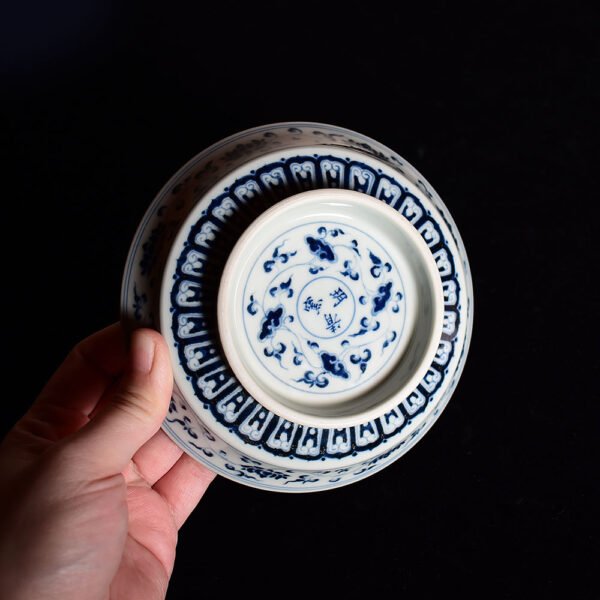 $945.99
$945.99The style of this super beautiful tea tray is Ming, using the underglaze blue technique, and entirely handcrafted and hand painted. The pattern features very traditional Chinese patterns including intertwining lotus and ‘Ba Bao’.
The “Ba Bao,” also known as the “Buddhist Eight Treasures” or “Eight Auspicious Treasures,” represent eight auspicious objects symbolizing the power of Buddhism. These symbols manifest through the perception of eight types of consciousness: eyes, ears, nose, tongue, body, mind, intellect, and consciousness. They are depicted in various patterns and motifs as decorations in Buddhist art.
During the Qing Dynasty, particularly during the reign of Emperor Qianlong, these eight auspicious symbols were transformed into three-dimensional display items. They were often placed together with ritual vessels in temples. The eight auspicious symbols are abbreviated as follows: Conch Shell, Dharma Wheel, Umbrella, Canopy, Lotus Flower, Vase, Fish, and Endless Knot.
According to Buddhist beliefs, each of the “Eight Auspicious Symbols” has specific symbolic meanings:
- Conch Shell: Represents the auspicious sound of the Dharma, spreading throughout the world as a symbol of good fortune.
- Dharma Wheel: Signifies the endless cycle of Buddhist teachings, symbolizing the continuity of life.
- Umbrella: Symbolizes protection and the ability to shield and safeguard all sentient beings.
- Canopy: Represents the protection of the world and purification of the universe, symbolizing liberation from poverty and illness.
- Lotus Flower: Symbolizes purity and divine birth, representing the rejection of contamination.
- Vase: Represents the perfection of wisdom and fulfillment, symbolizing the achievement of success.
- Fish: Symbolizes liveliness, health, and vitality, serving as a sign of good luck and warding off evil spirits.
- Endless Knot: Represents the interconnectedness and endless nature of all things, symbolizing longevity, and a hundred years of life.
The construction of these symbols focuses on using auspicious objects as the main decorative elements, with their forms often being symmetrical or balanced. Some are complemented by flowing ribbons, while others are placed on a lotus pedestal, creating a harmonious and coherent effect among the different auspicious treasures.
During the Tang and Song Dynasties, the Eight Auspicious Symbols were introduced to the central plains with the spread of Tibetan Buddhism. By the Yuan Dynasty, they began to appear on silk, ceramics, gold, and silver items. In the Ming and Qing Dynasties, the application of the Eight Auspicious Symbols became even more widespread, involving lacquerware, furniture, architectural decorations, and other areas of craftsmanship.
The delicate brushstrokes and intricate detailing of the painting on this tea tray create a distinct sense of aesthetic appeal. The soft and elegant shade of underglaze blue, along with a hint of faint tin glaze, gives it a graceful and ethereal beauty under the light. This tea tray exudes a simple yet elegant charm, reminiscent of the style of imitation Ming, making it truly captivating and irresistible.

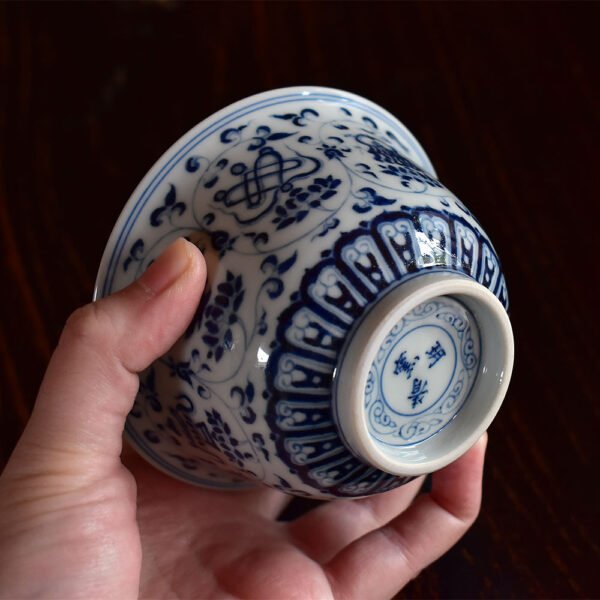 $749.99
$749.99The style of this super beautiful Gaiwan is Ming, using the underglaze blue technique, and entirely handcrafted and hand painted. The pattern features very traditional Chinese patterns including intertwining lotus and ‘Ba Bao’.
The “Ba Bao,” also known as the “Buddhist Eight Treasures” or “Eight Auspicious Treasures,” represent eight auspicious objects symbolizing the power of Buddhism. These symbols manifest through the perception of eight types of consciousness: eyes, ears, nose, tongue, body, mind, intellect, and consciousness. They are depicted in various patterns and motifs as decorations in Buddhist art.
During the Qing Dynasty, particularly during the reign of Emperor Qianlong, these eight auspicious symbols were transformed into three-dimensional display items. They were often placed together with ritual vessels in temples. The eight auspicious symbols are abbreviated as follows: Conch Shell, Dharma Wheel, Umbrella, Canopy, Lotus Flower, Vase, Fish, and Endless Knot.
According to Buddhist beliefs, each of the “Eight Auspicious Symbols” has specific symbolic meanings:
- Conch Shell: Represents the auspicious sound of the Dharma, spreading throughout the world as a symbol of good fortune.
- Dharma Wheel: Signifies the endless cycle of Buddhist teachings, symbolizing the continuity of life.
- Umbrella: Symbolizes protection and the ability to shield and safeguard all sentient beings.
- Canopy: Represents the protection of the world and purification of the universe, symbolizing liberation from poverty and illness.
- Lotus Flower: Symbolizes purity and divine birth, representing the rejection of contamination.
- Vase: Represents the perfection of wisdom and fulfillment, symbolizing the achievement of success.
- Fish: Symbolizes liveliness, health, and vitality, serving as a sign of good luck and warding off evil spirits.
- Endless Knot: Represents the interconnectedness and endless nature of all things, symbolizing longevity, and a hundred years of life.
The construction of these symbols focuses on using auspicious objects as the main decorative elements, with their forms often being symmetrical or balanced. Some are complemented by flowing ribbons, while others are placed on a lotus pedestal, creating a harmonious and coherent effect among the different auspicious treasures.
During the Tang and Song Dynasties, the Eight Auspicious Symbols were introduced to the central plains with the spread of Tibetan Buddhism. By the Yuan Dynasty, they began to appear on silk, ceramics, gold, and silver items. In the Ming and Qing Dynasties, the application of the Eight Auspicious Symbols became even more widespread, involving lacquerware, furniture, architectural decorations, and other areas of craftsmanship.
The delicate brushstrokes and intricate detailing of the painting on this Gaiwan create a distinct sense of aesthetic appeal. The soft and elegant shade of underglaze blue, along with a hint of faint tin glaze, gives it a graceful and ethereal beauty under the light. This Gaiwan exudes a simple yet elegant charm, reminiscent of the style of imitation Ming, making it truly captivating and irresistible.
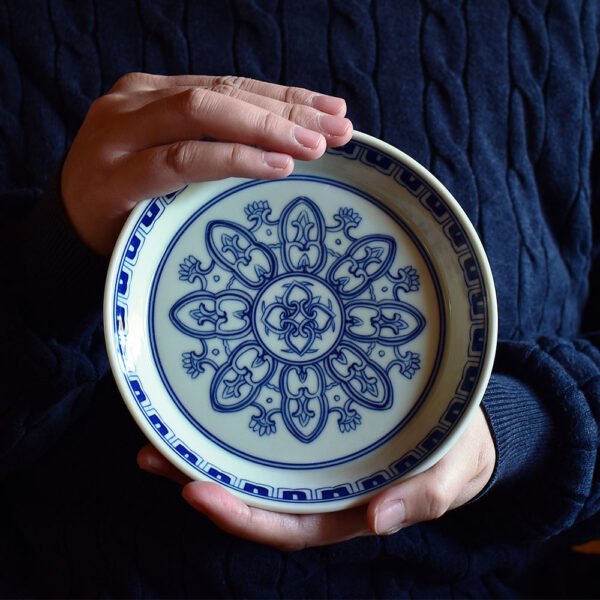
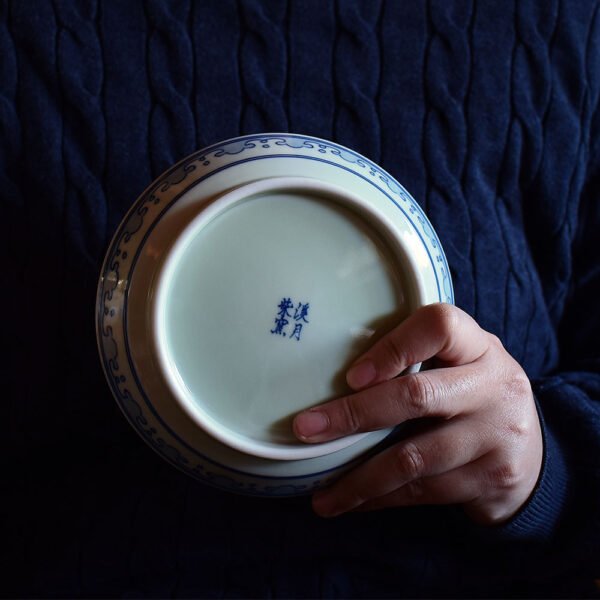 $195.99
$195.99This tea tray is completely handmade and hand-painted. The pattern featured is called “Bao Xiang” in Chinese, which is a traditional decorative motif representing one of the auspicious three treasures (Bao Xiang flower, Money tree, and Treasure basin), prevalent during the Sui and Tang dynasties in China. Bao Xiang pattern is also known as ‘Bao Xian Hua’ or ‘Bao Lian Hua’. Its lines are clear, and the colour is serene and antique. The Bao Xiang pattern design of this teaware is neat, and complex but not messy, and the whole picture of it is full and rich in details.
In Chinese culture, the Bao Xiang pattern symbolizes auspiciousness and happiness, representing people’s aspirations for happiness. It is widely popular in the decoration of silk brocade, bronze mirrors, and porcelain, showcasing people’s pursuit of a better life.
This tea tray features smooth and concise curves, combining the unique beauty of the Bao Xiang pattern, creating a visually appealing and enjoyable tea-drinking experience.




